
MiniCPM
MiniCPM4 & MiniCPM4.1: Ultra-Efficient LLMs on End Devices, achieving 3+ generation speedup on reasoning tasks
Stars: 8310
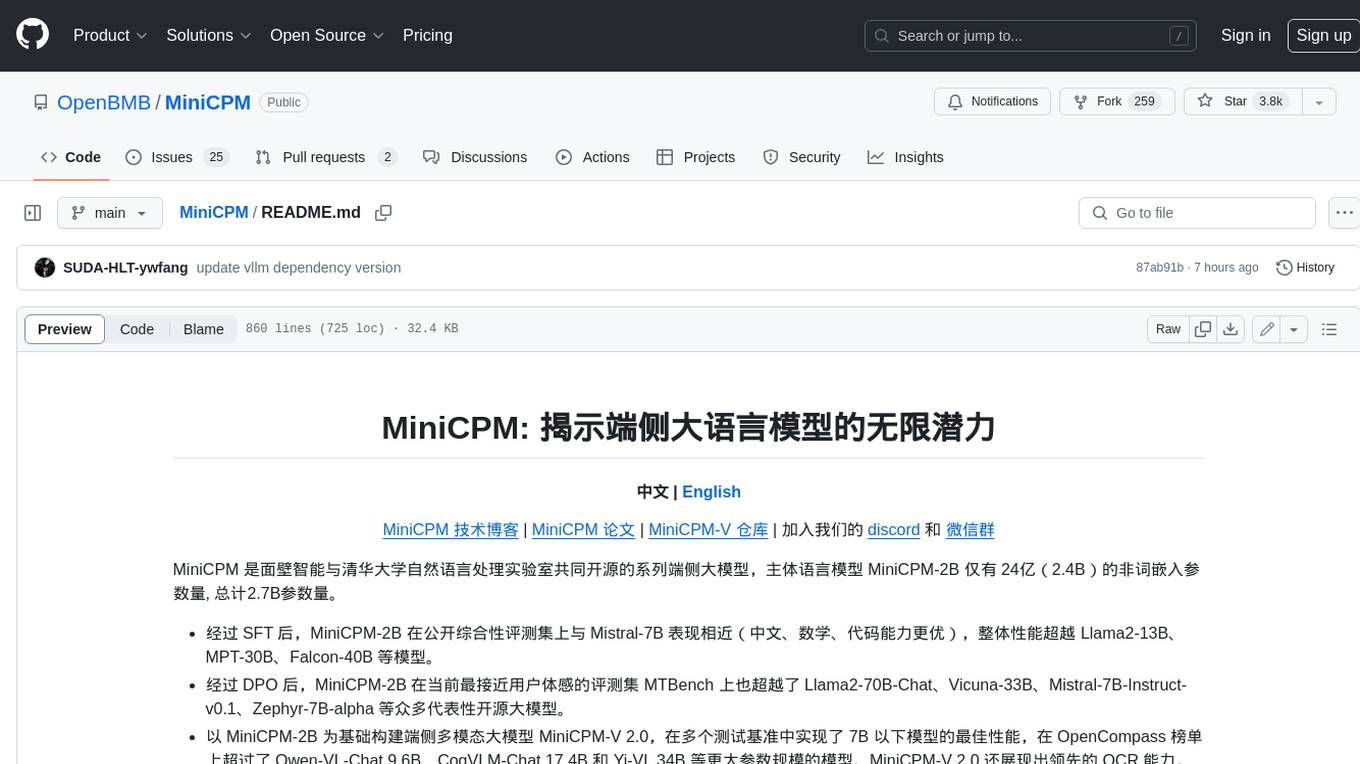
MiniCPM is a series of open-source large models on the client side jointly developed by Face Intelligence and Tsinghua University Natural Language Processing Laboratory. The main language model MiniCPM-2B has only 2.4 billion (2.4B) non-word embedding parameters, with a total of 2.7B parameters. - After SFT, MiniCPM-2B performs similarly to Mistral-7B on public comprehensive evaluation sets (better in Chinese, mathematics, and code capabilities), and outperforms models such as Llama2-13B, MPT-30B, and Falcon-40B overall. - After DPO, MiniCPM-2B also surpasses many representative open-source large models such as Llama2-70B-Chat, Vicuna-33B, Mistral-7B-Instruct-v0.1, and Zephyr-7B-alpha on the current evaluation set MTBench, which is closest to the user experience. - Based on MiniCPM-2B, a multi-modal large model MiniCPM-V 2.0 on the client side is constructed, which achieves the best performance of models below 7B in multiple test benchmarks, and surpasses larger parameter scale models such as Qwen-VL-Chat 9.6B, CogVLM-Chat 17.4B, and Yi-VL 34B on the OpenCompass leaderboard. MiniCPM-V 2.0 also demonstrates leading OCR capabilities, approaching Gemini Pro in scene text recognition capabilities. - After Int4 quantization, MiniCPM can be deployed and inferred on mobile phones, with a streaming output speed slightly higher than human speech speed. MiniCPM-V also directly runs through the deployment of multi-modal large models on mobile phones. - A single 1080/2080 can efficiently fine-tune parameters, and a single 3090/4090 can fully fine-tune parameters. A single machine can continuously train MiniCPM, and the secondary development cost is relatively low.
README:
中文 | English
MiniCPM 论文 | MiniCPM 技术博客 | MiniCPM 知识库 | MiniCPM-V 仓库 | 加入我们的 discord 和 微信群 | 加入我们
- [2025.09.05] 发布 MiniCPM4.1!该模型基于原生稀疏注意力架构(InfLLM v2),支持混合思考。🔥🔥🔥
- [2025.07.01] 发布 :MiniCPM Intel AIPC Client: 端侧大模型客户端 专为搭载 Intel Core Ultra 系列处理器的设备设计!全面支持 Intel Core Ultra 系列处理器,实现与硬件的深度融合
- [2025.06.06] 发布 MiniCPM4!该模型在保持同等规模最优性能的同时,实现了极致的效率提升!在典型端侧芯片上能够实现 5 倍以上生成加速!
- [2024.09.28] LLMxMapReduce 开源,支持 MiniCPM3-4B,理论上支持无限长文本输入!
- [2024.09.18] SGLang 已经支持 MiniCPM3-4B (推荐使用)!由于 SGLang v0.3 对 MiniCPM3 中使用的 MLA 结构进行了推理优化,吞吐量相比于 vLLM 提高 70%![用法]
- [2024.09.16] llama.cpp 已经官方支持 MiniCPM3-4B![GGUF模型|用法]
- [2024.09.05] 发布 MiniCPM3-4B!该模型的表现超越 Phi-3.5-mini-instruct 和 GPT-3.5-Turbo-0125,并且能够比肩 Llama3.1-8B-Instruct、Qwen2-7B-Instruct、GLM-4-9B-Chat 等多个 7B-9B 参数量的模型。
- [2024.07.09] MiniCPM-2B 已经支持使用 SGLang 推理!
- [2024.07.05] 发布 MiniCPM-S-1B!该模型在保持下游任务性能无损的前提下,FFN 层实现了 87.89% 的平均稀疏度,将 FFN FLOPs 降低了 84%。
- [2024.04.11] 发布 MiniCPM-2B-128k、MiniCPM-MoE-8x2B 和 MiniCPM-1B!点击这里查看技术博客。
- [2024.03.16] MiniCPM-2B 的 30 余个中间检查点开放了!HuggingFace链接
- [2024.02.01] 发布 MiniCPM-2B!该模型在公开评测集上与 Mistral-7B 表现相近(中文、数学、代码能力更优),整体性能超越 Llama2-13B、MPT-30B、Falcon-40B 等模型。
- 更新日志🔥
- 目录
- 模型下载
- MiniCPM4 和 MiniCPM4.1 系列
- MiniCPM 3.0
- MiniCPM 2.0
- MiniCPM 1.0
- 开源协议
- 开发机构
- 工作引用
📋 点击展开查看所有 MiniCPM 系列模型
MiniCPM4.1具有如下亮点:
✅ 强大的推理能力:在15项任务中超越同等规模模型!
✅ 快速生成:相比同等规模模型,推理解码速度提升3倍!
✅ 高效架构:使用可训练的稀疏注意力机制、高效投机解码加速生成!
MiniCPM4 和 MiniCPM4.1 系列是一个极致高效的端侧大模型,从模型架构、学习算法、训练数据与推理系统四个层面进行了高效优化,实现了极致的效率提升。
- 🏗️ 高效模型架构:
- InfLLM v2 -- 可训练的稀疏注意力机制:采用可训练的稀疏注意力机制架构,在 128K 长文本处理中,每个词元仅需与不足 5% 的词元进行相关性计算,显著降低长文本的计算开销
- 🧠 高效学习算法:
- 模型风洞 2.0 -- 高效 Predictable Scaling:引入下游任务的 Scaling 预测方法,实现更精准的模型训练配置搜索
- BitCPM -- 极致的三值量化:将模型参数位宽压缩至 3 值,实现模型位宽 90% 的极致瘦身
- 高效训练工程优化:采用 FP8 低精度计算技术,结合多词元预测(Multi-token Prediction)训练策略
- 📚 高知识密度训练数据:
- UltraClean -- 高质量预训练数据的清洗与合成:构建基于高效验证的迭代式数据清洗策略,开源高质量中英文预训练数据集 UltraFineweb
- UltraChat v2 -- 高质量有监督微调数据合成:构建大规模高质量有监督微调数据集,涵盖知识密集型数据、推理密集型数据、指令遵循数据、长文本理解数据、工具调用数据等多个维度
- ⚡ 高效推理系统:
- CPM.cu -- 轻量级的高效CUDA推理框架:融合了稀疏注意力机制、模型量化与投机采样,充分体现MiniCPM4的效率优势
- ArkInfer -- 跨平台部署系统:支持多后端环境的一键部署,提供灵活的跨平台适配能力
在 Jetson AGX Orin 和 RTX 4090 两款典型端侧芯片上,MiniCPM4 和 MiniCPM4.1 在长文本处理任务中展现出大幅领先同尺寸模型的处理速度。随着文本长度的增加,MiniCPM4 和 MiniCPM4.1 的性能优势愈发显著。在 Jetson AGX Orin 平台上,相较于 Qwen3-8B,MiniCPM4 实现了约 7 倍的生成速度提升。
MiniCPM4.1 在推理速度上实现了 3 倍的生成速度提升。
MiniCPM4 推出端侧 8B、0.5B 两种参数规模版本,均在同级别模型中实现了最佳性能表现。

MiniCPM4.1 推出端侧 8B 参数规模版本,深思考模式在同级别模型中实现了最佳性能表现。

MiniCPM4 基于 32K 长文本进行预训练,并通过 YaRN 技术实现长度扩展。在 128K 长文本的大海捞针任务中,MiniCPM4 展现出卓越的性能表现。MiniCPM4.1 基于 64K 长文本进行预训练,并通过 YaRN 技术实现长度扩展。在 128K 长文本的大海捞针任务中,MiniCPM4.1 展现出卓越的性能表现。
BitCPM4 是基于 MiniCPM 系列模型进行量化感知训练(QAT)后得到的三值量化模型,在训练效率和模型参数效率实现了有效的提升。
- 训练方法改进
- 在小规模模型上进行风洞实验,搜索训练所需的训练超参。
- 通过使用一阶段高精训练+二阶段 QAT 的方法,充分利用已经完成或部分完成训练的高精度模型,极大地压缩了 QAT 阶段所需要的算力。
- 高效参数效率
- 模型使用 1.58Bit 的位宽达到的性能对标与同参数量级别的全精度模型,模型参数效率高。
BitCPM4 在测试中的表现可以对标同级别的业界主流全精度模型。

BitCPM4 开源的模型参数为伪量化形式,可以直接使用 Huggingface 框架进行推理。
查看 MiniCPM4 的应用
#### MiniCPM4-Survey: 综述生成 MiniCPM4-Survey 是由 [THUNLP](https://nlp.csai.tsinghua.edu.cn)、中国人民大学和 [ModelBest](https://modelbest.cn/en) 联合开发的开源大语言模型智能体。它基于 MiniCPM4-8B 基座模型,接受用户质量作为输入,自主生成可信的长篇综述论文。 主要特性包括: - 计划-检索-写作生成框架 — 我们提出了一个多智能体生成框架,包含三个核心阶段:计划(定义综述的整体结构)、检索(生成合适的检索关键词)和写作(利用检索到的信息,生成连贯的段落)。 - 高质量数据集构建——我们收集并处理大量人类专家写作的综述论文,构建高质量训练集。同时,我们收集大量研究论文,构建检索数据库。 - 多方面奖励设计 — 我们精心设计了包含结构、内容和引用的奖励,用于评估综述的质量,在强化学习训练阶段作奖励函数。 - 多步强化学习训练策略 — 我们提出了一个上下文管理器,以确保在促进有效推理的同时保留必要的信息,并构建了并行环境,维持强化学习训练高效。 ##### 使用与演示案例详见此处
| Method | Relevance | Coverage | Depth | Novelty | Avg. | Fact Score |
|---|---|---|---|---|---|---|
| Naive RAG (driven by G2FT) | 3.25 | 2.95 | 3.35 | 2.60 | 3.04 | 43.68 |
| AutoSurvey (driven by G2FT) | 3.10 | 3.25 | 3.15 | 3.15 | 3.16 | 46.56 |
| Webthinker (driven by WTR1-7B) | 3.30 | 3.00 | 2.75 | 2.50 | 2.89 | -- |
| Webthinker (driven by QwQ-32B) | 3.40 | 3.30 | 3.30 | 2.50 | 3.13 | -- |
| OpenAI Deep Research (driven by GPT-4o) | 3.50 | 3.95 | 3.55 | 3.00 | 3.50 | -- |
| MiniCPM4-Survey | 3.45 | 3.70 | 3.85 | 3.00 | 3.50 | 68.73 |
| w/o RL | 3.55 | 3.35 | 3.30 | 2.25 | 3.11 | 50.24 |
GPT-4o 对综述生成系统的性能比较。“G2FT” 代表 Gemini-2.0-Flash-Thinking,“WTR1-7B” 代表 Webthinker-R1-7B。由于 Webthinker 不包括引用功能,OpenAI Deep Research 在导出结果时不提供引用,因此省略了对它们的 FactScore 评估。我们的技术报告中包含评测的详细信息。
MiniCPM4-MCP 是由清华大学自然语言处理实验室(THUNLP)、中国人民大学与 ModelBest 联合开发的开源本地大语言模型代理,它基于 MiniCPM-4-8B,拥有 80 亿参数。它能够通过 MCP 协议与各种工具和数据资源交互,解决多种真实世界任务。截至目前,MiniCPM4-MCP 已支持:
-
涵盖 16 个 MCP 服务器(servers)中工具的使用:这些服务器所包含的工具横跨了办公类、生活类、通讯类、资讯类、工作管理类等.
-
单工具使用的能力:可使用符合 MCP 协议的工具进行单一工具的一步或多步调用。
-
跨工具组合使用的能力:可组合使用符合 MCP 协议的不同工具。
详见此处
| MCP 服务器 | gpt-4o | qwen3 | minicpm4 | ||||||
|---|---|---|---|---|---|---|---|---|---|
| 函数名正确率 | 参数名正确率 | 数值正确率 | 函数名正确率 | 参数名正确率 | 数值正确率 | 函数名正确率 | 参数名正确率 | 数值正确率 | |
| Airbnb | 89.3 | 67.9 | 53.6 | 92.8 | 60.7 | 50.0 | 96.4 | 67.9 | 50.0 |
| Amap-Maps | 79.8 | 77.5 | 50.0 | 74.4 | 72.0 | 41.0 | 89.3 | 85.7 | 39.9 |
| Arxiv-MCP-Server | 85.7 | 85.7 | 85.7 | 81.8 | 54.5 | 50.0 | 57.1 | 57.1 | 52.4 |
| Calculator | 100.0 | 100.0 | 20.0 | 80.0 | 80.0 | 13.3 | 100.0 | 100.0 | 6.67 |
| Computor-Control-MCP | 90.0 | 90.0 | 90.0 | 90.0 | 90.0 | 90.0 | 90.0 | 90.0 | 86.7 |
| Desktop-Commander | 100.0 | 100.0 | 100.0 | 100.0 | 100.0 | 100.0 | 100.0 | 100.0 | 100.0 |
| Filesystem | 63.5 | 63.5 | 31.3 | 69.7 | 69.7 | 26.0 | 83.3 | 83.3 | 42.7 |
| Github | 92.0 | 80.0 | 58.0 | 80.5 | 50.0 | 27.7 | 62.8 | 25.7 | 17.1 |
| Gaode | 71.1 | 55.6 | 17.8 | 68.8 | 46.6 | 24.4 | 68.9 | 46.7 | 15.6 |
| MCP-Code-Executor | 85.0 | 80.0 | 70.0 | 80.0 | 80.0 | 70.0 | 90.0 | 90.0 | 65.0 |
| MCP-Docx | 95.8 | 86.7 | 67.1 | 94.9 | 81.6 | 60.1 | 95.1 | 86.6 | 76.1 |
| PPT | 72.6 | 49.8 | 40.9 | 85.9 | 50.7 | 37.5 | 91.2 | 72.1 | 56.7 |
| PPTx | 64.2 | 53.7 | 13.4 | 91.0 | 68.6 | 20.9 | 91.0 | 58.2 | 26.9 |
| Simple-Time-Server | 90.0 | 70.0 | 70.0 | 90.0 | 90.0 | 90.0 | 90.0 | 60.0 | 60.0 |
| Slack | 100.0 | 90.0 | 70.0 | 100.0 | 100.0 | 65.0 | 100.0 | 100.0 | 100.0 |
| Whisper | 90.0 | 90.0 | 90.0 | 90.0 | 90.0 | 90.0 | 90.0 | 90.0 | 30.0 |
| 平均值 | 80.2 | 70.2 | 49.1 | 83.5 | 67.7 | 43.8 | 88.3 | 76.1 | 51.2 |
MiniCPM Intel AIPC Client 是面壁智能和 Intel 合作推出的端侧大模型客户端,专为搭载 Intel Core Ultra 系列处理器的设备设计,旨在为开发者、研究人员与 AI 爱好者带来低延迟、高效率、高隐私的本地大模型使用体验。其核心特性如下:
- 深度适配 Intel 硬件:全面支持 Intel Core Ultra 系列处理器,实现与硬件的深度融合,充分释放硬件性能,让用户无需依赖云端,在本地设备上就能流畅运行大模型。
- 基于 OpenVINO 的极致优化:基于 OpenVINO 推理框架进行深度优化,大幅提升推理效率,推理速度最高可达每秒 80 tokens,确保模型响应迅速,无论是快速问答还是复杂任务处理,都能高效完成。
- 隐私安全保障:采用本地部署方式,所有数据处理均在本地设备完成,避免数据上传至云端带来的隐私风险,让用户使用更安心,尤其适合对数据隐私要求较高的场景。
- 面向多元用户群体:无论是追求前沿技术的开发者,专注学术研究的科研人员,还是热衷于探索 AI 应用的爱好者,都能通过 MiniCPM Intel AIPC Client,轻松体验本地大模型的强大功能,开启个性化的 AI 探索之旅 。
配置要求:
- 建议使用英特尔酷睿 ultra7 及以上移动端处理器
- 建议运行内存 32GB 及以上
应用下载:
你可以使用Huggingface Transformers、vLLM、SGLang、CPM.cu对模型进行推理。如果想要体验极致的效率优化,我们推荐使用CPM.cu。
MiniCPM4.1 支持混合思考模式,可以用于深度思考和非思考模式。用户可以通过设置 enable_thinking=True 来启用混合思考模式,设置 enable_thinking=False 来启用非思考模式。同样,用户可以直接在查询末尾添加 /no_think 来启用非思考模式。如果未添加任何特殊标记或在查询末尾添加 /think,模型将启用思考模式。
# Enable reasoning mode
prompt_text = tokenizer.apply_chat_template(
messages,
tokenize=False,
add_generation_prompt=True,
enable_thinking=True
)
# Enable non-reasoning mode
prompt_text = tokenizer.apply_chat_template(
messages,
tokenize=False,
add_generation_prompt=True,
enable_thinking=False
)from transformers import AutoModelForCausalLM, AutoTokenizer
import torch
torch.manual_seed(0)
path = 'openbmb/MiniCPM4.1-8B'
device = "cuda"
tokenizer = AutoTokenizer.from_pretrained(path)
model = AutoModelForCausalLM.from_pretrained(path, torch_dtype=torch.bfloat16, device_map=device, trust_remote_code=True)
# User can directly use the chat interface
# responds, history = model.chat(tokenizer, "Write an article about Artificial Intelligence.", temperature=0.7, top_p=0.7)
# print(responds)
# User can also use the generate interface
messages = [
{"role": "user", "content": "Write an article about Artificial Intelligence."},
]
prompt_text = tokenizer.apply_chat_template(
messages,
tokenize=False,
add_generation_prompt=True,
)
model_inputs = tokenizer([prompt_text], return_tensors="pt").to(device)
model_outputs = model.generate(
**model_inputs,
max_new_tokens=32768,
top_p=0.95,
temperature=0.6
)
output_token_ids = [
model_outputs[i][len(model_inputs[i]):] for i in range(len(model_inputs['input_ids']))
]
responses = tokenizer.batch_decode(output_token_ids, skip_special_tokens=True)[0]
print(responses)本模型支持稀疏注意力机制 InfLLM v2,可高效处理长序列推理。如需启用该功能,请先安装依赖库 infllmv2_cuda_impl
运行以下命令即可安装:
git clone -b feature_infer https://github.com/OpenBMB/infllmv2_cuda_impl.git
cd infllmv2_cuda_impl
git submodule update --init --recursive
pip install -e . # or python setup.py install 启用 InfLLM v2 需在 config.json 配置文件中添加 sparse_config 字段:
{
...,
"sparse_config": {
"kernel_size": 32,
"kernel_stride": 16,
"init_blocks": 1,
"block_size": 64,
"window_size": 2048,
"topk": 64,
"use_nope": false,
"dense_len": 8192
}
}这些参数控制 InfLLM v2 的行为:
-
kernel_size(默认值:32):语义核的大小。 -
kernel_stride(默认值:16):相邻语义核的步长。 -
init_blocks(默认值:1):每个 query token 关注的初始的块数量,用于确保关注序列开头部分。 -
block_size(默认值:64):key-value blocks 的块大小。 -
window_size(默认值:2048):局部滑动窗口大小。 -
topk(默认值:64):每个 token 仅与最相关的 top-k 个 key-value blocks 计算注意力。 -
use_nope(默认值:false):是否在块选择中使用NOPE技术以提升性能。 -
dense_len(默认值:8192):稀疏注意力对短序列收益有限,当 token 长度低于此阈值时自动切换为标准注意力。设为-1则强制始终使用稀疏注意力。
Minicpm4.1 原生支持 65,536 tokens 的上下文长度。若对话总长度(输入 + 输出)远超此限制,建议通过 RoPE 缩放技术扩展上下文。我们已验证通过调整 LongRoPE 因子,模型可稳定支持 131,072 tokens 的超长上下文。
修改方法:在 config.json 文件中调整 rope_scaling 字段参数即可。
{
...,
"rope_scaling": {
"rope_type": "longrope",
"long_factor": [0.9982316082870437, 1.033048153422584, 1.0749920956484724, 1.1255096879436193, 1.1863348602111476, 1.259543828902579, 1.3476188888731149, 1.4535223827776373, 1.5807816745852985, 1.7335856049489526, 1.9168922912975785, 2.1365471404135326, 2.3994084200118646, 2.713475511863602, 3.0880118452194134, 3.533650295140154, 4.062463396503134, 4.687974098908333, 5.425075306704039, 6.289818967956352, 7.29902962722721, 8.6357018163639, 10.210822723989212, 12.053807765671676, 14.193944598909404, 16.65780676784363, 19.463620727694074, 22.628311203524586, 26.150106147261315, 30.02526691405111, 34.23183327975347, 38.73811934094828, 43.502489489729555, 48.47627117965394, 53.61139491762471, 58.857366522037935, 64.16798299215064, 69.51359464319125, 74.86555458220285, 80.21497790341579, 85.55322183307433, 90.89611806932027, 96.26245306514224, 101.68269304046481, 107.18619510219668, 112.82253283014026, 118.63764063163615, 119.88866203644656, 120.9462882391725, 121.837565139014, 122.58663780572562, 123.2147719894291, 123.74049454862576, 124.17980424685767, 124.54641761955492, 124.85202548028222, 125.10654406389756, 125.31835105170659, 125.49450117164764, 125.64091910903052, 125.76256945356558, 125.86360463815589, 125.94749252260765, 126.01712561287873],
"short_factor": [0.9982316082870437, 1.033048153422584, 1.0749920956484724, 1.1255096879436193, 1.1863348602111476, 1.259543828902579, 1.3476188888731149, 1.4535223827776373, 1.5807816745852985, 1.7335856049489526, 1.9168922912975785, 2.1365471404135326, 2.3994084200118646, 2.713475511863602, 3.0880118452194134, 3.533650295140154, 4.062463396503134, 4.687974098908333, 5.425075306704039, 6.289818967956352, 7.29902962722721, 8.6357018163639, 10.210822723989212, 12.053807765671676, 14.193944598909404, 16.65780676784363, 19.463620727694074, 22.628311203524586, 26.150106147261315, 30.02526691405111, 34.23183327975347, 38.73811934094828, 43.502489489729555, 48.47627117965394, 53.61139491762471, 58.857366522037935, 64.16798299215064, 69.51359464319125, 74.86555458220285, 80.21497790341579, 85.55322183307433, 90.89611806932027, 96.26245306514224, 101.68269304046481, 107.18619510219668, 112.82253283014026, 118.63764063163615, 119.88866203644656, 120.9462882391725, 121.837565139014, 122.58663780572562, 123.2147719894291, 123.74049454862576, 124.17980424685767, 124.54641761955492, 124.85202548028222, 125.10654406389756, 125.31835105170659, 125.49450117164764, 125.64091910903052, 125.76256945356558, 125.86360463815589, 125.94749252260765, 126.01712561287873],
"original_max_position_embeddings": 65536
}
}你可以使用投机采样加速模型生成,也可以使用标准模式部署模型。
使用 vLLM 进行加速推理的投机采样步骤如下:
首先,下载 MiniCPM4.1 草稿模型:
cd /your_path
git clone https://huggingface.co/openbmb/MiniCPM4.1-8B-Eagle3EAGLE3 的 vLLM PR 已经提交。目前请使用我们的仓库进行安装:
git clone https://github.com/LDLINGLINGLING/vllm.git
cd vllm
pip install -e .启动启用了投机采样的 vLLM 推理服务。请确保在 speculative-config 中将模型路径更新为下载的 MiniCPM4_1-8B-Eagle3-bf16 文件夹:
VLLM_USE_V1=1 \
vllm serve openbmb/MiniCPM4.1-8B \
--seed 42 \
--trust-remote-code \
--speculative-config '{
"model": "your/path/MiniCPM4_1-8B-Eagle3-bf16",
"num_speculative_tokens": 3,
"method": "eagle3",
"draft_tensor_parallel_size": 1
}'客户端使用方式在标准解码和投机采样下保持一致:
import openai
client = openai.Client(base_url="http://localhost:8000/v1", api_key="EMPTY")
response = client.chat.completions.create(
model="openbmb/MiniCPM4.1-8B",
messages=[
{"role": "user", "content": "Write an article about Artificial Intelligence."},
],
temperature=0.6,
max_tokens=32768,
extra_body=dict(add_special_tokens=True), # 确保在聊天模板中加入特殊符号
)
print(response.choices[0].message.content)-
VLLM_USE_V1=1: 启用 vLLM v1 API -
--speculative-config: 投机采样的 JSON 配置 -
model: 草稿模型的路径 -
num_speculative_tokens: 推测的 token 数量(默认:3) -
method: 投机采样方法(eagle3) -
draft_tensor_parallel_size: 草稿模型的张量并行大小(默认:1) -
--seed: 随机种子,用于可复现性 -
--trust-remote-code: 允许执行远程代码以支持自定义模型
目前你需要安装最新版本的 vLLM。
pip install -U vllm \
--pre \
--extra-index-url https://wheels.vllm.ai/nightly然后可以用 vLLM 推理 MiniCPM4.1-8B:
from transformers import AutoTokenizer
from vllm import LLM, SamplingParams
model_name = "openbmb/MiniCPM4.1-8B"
prompt = [{"role": "user", "content": "Write an article about Artificial Intelligence."}]
tokenizer = AutoTokenizer.from_pretrained(model_name, trust_remote_code=True)
input_text = tokenizer.apply_chat_template(prompt, tokenize=False, add_generation_prompt=True)
llm = LLM(
model=model_name,
trust_remote_code=True,
max_num_batched_tokens=65536,
dtype="bfloat16",
gpu_memory_utilization=0.8,
)
sampling_params = SamplingParams(top_p=0.95, temperature=0.6, max_tokens=32768)
outputs = llm.generate(prompts=input_text, sampling_params=sampling_params)
print(outputs[0].outputs[0].text)你也可以通过以下命令启动推理服务:
注意: 在 vLLM 的 chat API 中,add_special_tokens 默认是 False。这意味着重要的特殊符号——比如序列开始符(BOS token)——不会被自动加入。为了确保输入提示对模型格式正确,建议显式设置 extra_body={"add_special_tokens": True}。
vllm serve openbmb/MiniCPM4.1-8B --trust-remote-code然后可以通过以下代码使用聊天接口:
import openai
client = openai.Client(base_url="http://localhost:8000/v1", api_key="EMPTY")
response = client.chat.completions.create(
model="openbmb/MiniCPM4.1-8B",
messages=[
{"role": "user", "content": "Write an article about Artificial Intelligence."},
],
temperature=0.6,
max_tokens=32768,
extra_body=dict(add_special_tokens=True), # 确保在聊天模板中加入特殊符号
)
print(response.choices[0].message.content)你可以使用投机采样加速模型生成,也可以使用标准模式部署模型。
使用投机采样进行加速推理的步骤如下:
首先,下载 MiniCPM4.1 草稿模型:
cd /your_path
git clone https://huggingface.co/openbmb/MiniCPM4.1-8B-Eagle3EAGLE3 的适配 PR 已经提交。目前请使用我们的仓库进行安装:
git clone https://github.com/LDLINGLINGLING/sglang.git
cd sglang
pip install -e .启动启用了投机采样的 SGLang 服务:
python -m sglang.launch_server \
--model-path "openbmb/MiniCPM4.1-8B" \
--host "127.0.0.1" \
--port 30002 \
--mem-fraction-static 0.9 \
--speculative-algorithm EAGLE3 \
--speculative-draft-model-path "your/path/MiniCPM4_1-8B-Eagle3-bf16" \
--speculative-num-steps 3 \
--speculative-eagle-topk 1 \
--speculative-num-draft-tokens 32 \
--temperature 0.7客户端使用方式在标准解码和投机采样下保持一致:
import openai
client = openai.Client(base_url=f"http://localhost:30002/v1", api_key="None")
response = client.chat.completions.create(
model="openbmb/MiniCPM4.1-8B",
messages=[
{"role": "user", "content": "Write an article about Artificial Intelligence."},
],
temperature=0.6,
max_tokens=32768,
)
print(response.choices[0].message.content)注意:请确保在客户端代码中更新端口号,以匹配服务端端口(在投机采样示例中为 30002)。
-
--speculative-algorithm EAGLE3: 启用 EAGLE3 投机采样 -
--speculative-draft-model-path: 草稿模型路径 -
--speculative-num-steps: 推测步数(默认:3) -
--speculative-eagle-topk: EAGLE 的 top-k 参数(默认:1) -
--speculative-num-draft-tokens: 草稿 token 数量(默认:32) -
--mem-fraction-static: 静态分配的显存比例(默认:0.9)
目前你需要安装我们 fork 的 SGLang 版本。
git clone -b openbmb https://github.com/OpenBMB/sglang.git
cd sglang
pip install --upgrade pip
pip install -e "python[all]"你可以通过以下命令启动推理服务:
python -m sglang.launch_server --model openbmb/MiniCPM4.1-8B --trust-remote-code --port 30000 --chat-template chatml然后可以通过以下代码使用聊天接口:
import openai
client = openai.Client(base_url=f"http://localhost:30000/v1", api_key="None")
response = client.chat.completions.create(
model="openbmb/MiniCPM4.1-8B",
messages=[
{"role": "user", "content": "Write an article about Artificial Intelligence."},
],
temperature=0.6,
max_tokens=32768,
)
print(response.choices[0].message.content)我们推荐使用 CPM.cu 对 MiniCPM4 和 MiniCPM4.1 模型进行推理。CPM.cu 是面壁开发的一个集合了高效稀疏、投机采样、量化等技术的 CUDA 推理框架,能够完全发挥 MiniCPM4 和 MiniCPM4.1 的效率优势。
你可以通过以下脚本安装 CPM.cu 并进行推理:
git clone https://github.com/OpenBMB/CPM.cu.git --recursive
cd CPM.cu
python3 setup.py install你可以通过以下命令进行推理并查看模型的运行速度。
python3 tests/long_prompt_gen.py # 生成 prompt.txt
python3 tests/test_generate.py --prompt-file prompt.txt你可以通过一下命令使用 EAGLE3 进行投机推理。
python3 -m cpmcu.cli \
--model-path $BASE_MODEL_PATH \
--draft-model-path $EAGLE3_DRAFT_MODEL_PATH \
--prompt-text "Tell me about Tsinghua University" \
--use-eagle3 true更多关于 CPM.cu 的细节,请参考 CPM.cu 仓库。
目前模型微调支持 LLaMA-Factory,使用方法参考 LLaMA-Factory 微调
查看 MiniCPM 3.0 的详细信息
MiniCPM 3.0 是一个 4B 参数量的语言模型,相比 MiniCPM1.0/2.0,功能更加全面,综合能力大幅提升,多数评测集上的效果比肩甚至超越众多 7B-9B 模型。
- 支持工具调用🛠️(Function Calling)和代码解释器💻(Code Interpreter):Berkeley Function Calling Leaderboard (BFCL) 上取得 9B 规模以下 SOTA,超越 GLM-4-9B-Chat、Qwen2-7B-Instruct。
- 超强的推理能力🧮:数学能力方面,MathBench 上的效果超越 GPT-3.5-Turbo 以及多个 7B-9B 模型。在非常具有挑战性的 LiveCodeBench 上,效果超越 Llama3.1-8B-Instruct。
- 出色的中英文指令遵循能力🤖:英文指令遵循 IFEval、中文指令遵循 FollowBench-zh 效果超越 GLM-4-9B-Chat、Qwen2-7B-Instruct。
- 长文本能力:原生支持 32k 上下文长度,32k 长度内大海捞针全绿。提出 LLMxMapReduce ,理论可处理的上下文长度达到 +∞,在综合性长文本评测基准 InfiniteBench 平均得分超越GPT-4、KimiChat等标杆模型。
- RAG能力:我们发布了 MiniCPM RAG 套件。基于 MiniCPM 系列模型的 MiniCPM-Embedding、MiniCPM-Reranker 在中文、中英跨语言检索测试中取得 SOTA 表现;针对 RAG 场景的 MiniCPM3-RAG-LoRA 在开放域问答等多项任务上超越 Llama3-8B、Baichuan2-13B 等模型。
| 评测集 | Qwen2-7B-Instruct | GLM-4-9B-Chat | Gemma2-9B-it | Llama3.1-8B-Instruct | GPT-3.5-Turbo-0125 | Phi-3.5-mini-Instruct(3.8B) | MiniCPM3-4B | |||||||
| 英文能力 | ||||||||||||||
| MMLU | 70.5 | 72.4 | 72.6 | 69.4 | 69.2 | 68.4 | 67.2 | |||||||
| BBH | 64.9 | 76.3 | 65.2 | 67.8 | 70.3 | 68.6 | 70.2 | |||||||
| MT-Bench | 8.41 | 8.35 | 7.88 | 8.28 | 8.17 | 8.60 | 8.41 | |||||||
| IFEVAL (Prompt Strict-Acc.) | 51.0 | 64.5 | 71.9 | 71.5 | 58.8 | 49.4 | 68.4 | |||||||
| 中文能力 | ||||||||||||||
| CMMLU | 80.9 | 71.5 | 59.5 | 55.8 | 54.5 | 46.9 | 73.3 | |||||||
| CEVAL | 77.2 | 75.6 | 56.7 | 55.2 | 52.8 | 46.1 | 73.6 | |||||||
| AlignBench v1.1 | 7.10 | 6.61 | 7.10 | 5.68 | 5.82 | 5.73 | 6.74 | |||||||
| FollowBench-zh (SSR) | 63.0 | 56.4 | 57.0 | 50.6 | 64.6 | 58.1 | 66.8 | |||||||
| 数学能力 | ||||||||||||||
| MATH | 49.6 | 50.6 | 46.0 | 51.9 | 41.8 | 46.4 | 46.6 | |||||||
| GSM8K | 82.3 | 79.6 | 79.7 | 84.5 | 76.4 | 82.7 | 81.1 | |||||||
| MathBench | 63.4 | 59.4 | 45.8 | 54.3 | 48.9 | 54.9 | 65.6 | |||||||
| 代码能力 | ||||||||||||||
| HumanEval+ | 70.1 | 67.1 | 61.6 | 62.8 | 66.5 | 68.9 | 68.3 | |||||||
| MBPP+ | 57.1 | 62.2 | 64.3 | 55.3 | 71.4 | 55.8 | 63.2 | |||||||
| LiveCodeBench v3 | 22.2 | 20.2 | 19.2 | 20.4 | 24.0 | 19.6 | 22.6 | |||||||
| 工具调用能力 | ||||||||||||||
| BFCL v2 | 71.6 | 70.1 | 19.2 | 73.3 | 75.4 | 48.4 | 76.0 | |||||||
| 综合能力 | ||||||||||||||
| 平均分 | 65.3 | 65.0 | 57.9 | 60.8 | 61.0 | 57.2 | 66.3 | |||||||
我们在 Berkeley Function Calling Leaderboard (BFCL) 上测试了模型的工具调用能力,MiniCPM3-4B 在该榜单上的表现超越了多个 7B-9B 参数量的模型,优于 GPT-3.5-Turbo-0125。
| 模型 | 总体准确率 | AST Summary | Exec Summary | Irrelevance Detection | Relevance Detection |
| MiniCPM3-4B | 76.03% | 68.55% | 85.54% | 53.71% | 90.24% |
| Llama3.1-8B-Instruct | 73.28% | 64.61% | 86.48% | 43.12% | 85.37% |
| Qwen2-7B-Instruct | 71.61% | 65.71% | 79.57% | 44.70% | 90.24% |
| GLM-4-9B-Chat | 70.08% | 60.69% | 80.02% | 55.02% | 82.93% |
| Phi-3.5-mini-instruct | 48.44% | 38.89% | 54.04% | 46.78% | 65.85% |
| Gemma2-9B-it | 19.18% | 5.41% | 18.50% | 88.88% | 7.32% |
在 32k 的上下文长度进行大海捞针测试,结果如下图:
同时我们提出LLMxMapReduce,利用分治的策略,理论上可以处理无限长度的文本。我们在InfiniteBench上测试了模型的长文本处理能力,在LLMxMapReduce框架的加持下,MiniCPM3-4B在这个榜单的平均得分能够超越 GPT-4、KimiChat 等标杆模型。
| Context length | Qwen2-70b | Kimi-Chat(2024.06) | GPT-4 (From InfiniteBench) | MiniCPM 3.0 x MR | Qwen2-70b x MR | Llama3-70bx MR | |
|---|---|---|---|---|---|---|---|
| Math.Find | 87.9k | 59.71% | 18.57% | 60.00% | 83.43% | 54.29% | 91.43% |
| Retrieve.KV | 89.9k | 29.00% | 69.20% | 89.00% | 93.80% | 98.80% | 98.89% |
| En.Dia | 103.6K | 23.00% | 23.00% | 7.50% | 12.50% | 46.50% | 17.50% |
| Code.Debug | 114.7k | 45.43% | 38.32% | 54.31% | 25.63% | 54.82% | 62.94% |
| Retrieve.Number | 122.4k | 100.00% | 97.45% | 100.00% | 99.32% | 100.00% | 99.79% |
| Retrieve.PassKey | 122.4k | 100.00% | 99.32% | 100.00% | 98.81% | 100.00% | 100.00% |
| En.Sum | 171.5K | 31.85% | 29.94% | 14.73% | 25.89% | 32.39% | 30.63% |
| En.MC | 184.4k | 81.66% | 79.91% | 68.12% | 66.38% | 83.84% | 82.10% |
| En.QA | 192.6k | 21.97% | 18.80% | 22.44% | 28.39% | 23.13% | 34.70% |
| Zh.QA | 2068.6k | 21.40% | 19.84% | 25.96% | 23.66% | 19.10% | N/A |
| avg w/o Zh.QA | / | 51.92% | 52.96% | 55.33% | 59.29% | 64.98% | 68.64% |
| avg | / | 48.86% | 49.65% | 52.39% | 55.55% | 60.39% | N/A |
from transformers import AutoModelForCausalLM, AutoTokenizer
import torch
torch.manual_seed(0)
path = 'openbmb/MiniCPM3-4B'
tokenizer = AutoTokenizer.from_pretrained(path)
model = AutoModelForCausalLM.from_pretrained(path, torch_dtype=torch.bfloat16, device_map='cuda', trust_remote_code=True)
responds, history = model.chat(tokenizer, "请写一篇关于人工智能的文章,详细介绍人工智能的未来发展和隐患。", temperature=0.7, top_p=0.7)
print(responds)- 安装
参考 SGLang 官方仓库,通过源码安装最新版本。
- 启动推理服务
python -m sglang.launch_server --model openbmb/MiniCPM3-4B --trust-remote-code --port 30000 --chat-template chatml- 使用示例
from sglang import function, system, user, assistant, gen, set_default_backend, RuntimeEndpoint
@function
def multi_turn_question(s, question_1, question_2):
s += user(question_1)
s += assistant(gen("answer_1", max_tokens=1024))
s += user(question_2)
s += assistant(gen("answer_2", max_tokens=1024))
set_default_backend(RuntimeEndpoint("http://localhost:30000"))
state = multi_turn_question.run(
question_1="介绍一下人工智能",
question_2="写一篇关于它的文章",
)
for m in state.messages():
print(m["role"], ":", m["content"])- 安装 vllm
pip install "vllm>=0.6.2" - 推理
from transformers import AutoTokenizer from vllm import LLM, SamplingParams model_name = "openbmb/MiniCPM3-4B" prompt = [{"role": "user", "content": "请写一篇关于人工智能的文章,详细介绍人工智能的未来发展和隐患。"}] tokenizer = AutoTokenizer.from_pretrained(model_name, trust_remote_code=True) input_text = tokenizer.apply_chat_template(prompt, tokenize=False, add_generation_prompt=True) llm = LLM(model=model_name, trust_remote_code=True, tensor_parallel_size=1 ) sampling_params = SamplingParams(top_p=0.7, temperature=0.7, max_tokens=1024) outputs = llm.generate(prompts=input_text, sampling_params=sampling_params) print(outputs[0].outputs[0].text)
我们提供了 MiniCPM3 的 GGUF 版本,可以直接使用 llama.cpp 推理。
- 安装 llama.cpp
git clone https://github.com/ggerganov/llama.cpp cd llama.cpp make - 推理
./llama-cli -c 1024 -m minicpm3-4b-fp16.gguf -n 1024 --top-p 0.7 --temp 0.7 --prompt "<|im_start|>user\n请写一篇关于人工智能的文章,详细介绍人工智能的未来发展和隐患。<|im_end|>\n<|im_start|>assistant\n"
目前模型微调支持 LLaMA-Factory,使用方法参考 LLaMA-Factory 微调。
对于以下进阶功能,我们的样例代码中使用 vLLM 进行推理。
我们提供了使用 MiniCPM3 调用工具的示例代码:
cd demo/minicpm3/function_call
python function_call.py如果你想启动一个能够调用工具的推理服务,使用以下代码:
cd demo/minicpm3/function_call
pip install -r requirements.txt
python openai_api_server.py \
--model openbmb/MiniCPM3-4B \
--served-model-name MiniCPM3-4B \
--chat-template chatml.jinja \
--dtype auto \
--api-key token-abc123 \
--tensor-parallel-size 1 \
--trust-remote-code下面是一个调用搜索工具回答问题的演示:
我们提供了一个 MiniCPM3 使用代码解释器的示例代码:
cd demo/minicpm3/code_interpreter
pip install -r requirements.txt
python code_interpreter.py openbmb/MiniCPM3-4B下面是一个使用代码解释器生成二维码的演示:
查看 MiniCPM 2.0 的详细信息
MiniCPM 2.0 系列模型对 MiniCPM 进行了多个维度的升级,包括以下模型版本:
- MiniCPM-2B-128k:将 MiniCPM-2B 的上下文长度从 4k 扩展至 128k,在 InfiniteBench 测试集上优于 ChatGLM3-6B-128k、Yi-6B-200k 等更大参数量的模型。
- MiniCPM-MoE-8x2B:基于 MiniCPM-2B 进行 MoE 扩展,综合表现相比于 MiniCPM-2B 平均提高 4.5 个百分点。
- MiniCPM-1B:相比于 MiniCPM-2B 成本下降 60%,综合表现仍然优于 LLaMA2-13B。
- MiniCPM-S-1B:在保持下游任务性能无损的前提下,FFN 层实现了 87.89% 的平均稀疏度,将 FFN FLOPs 降低了 84%。结合 PowerInfer 推理框架,解码速度提升约 2.8 倍。
| Model | avg | avg w/o code&math | passkey | number_string | kv_retrieval | longbook_choice_eng | longbook_qa_chn | longbook_qa_eng | longbook_sum_eng | longdialogue_qa_eng | math_calc | math_find | code_debug | code_run |
|---|---|---|---|---|---|---|---|---|---|---|---|---|---|---|
| LWM-Text-128k | 24.45 | 33.62 | 100 | 97.8 | 0.6 | 28.82 | 15.93 | 14.31 | 9.99 | 1.5 | 0 | 3.43 | 20.05 | 1 |
| Yarn-Mistral-7b-128k | 19.84 | 27.36 | 92.71 | 0 | 27.95 | 15.49 | 9.55 | 9.06 | 7.5 | 0 | 17.14 | 0.76 | 1.25 | |
| Mistral-7B-Instruct-v0.2(ABF 1000w) | 27.75 | 36.9 | 100 | 78.98 | 3.6 | 37.12 | 11.74 | 17.37 | 21.12 | 9.5 | 0 | 29.43 | 17.51 | 0 |
| Yi-6B-200k | 22.15 | 32.54 | 100 | 94.92 | 0 | 36.68 | 15.07 | 9.2 | 0.92 | 3.5 | 0 | 4.29 | 0.51 | 0.75 |
| chatglm3-6b-128k | 25.58 | 36.57 | 89.93 | 99.66 | 5.2 | 46.29 | 10.7 | 8.38 | 25.91 | 6.5 | 0 | 8 | 5.33 | 1 |
| MiniCPM-2.4B-128k | 27.32 | 37.68 | 98.31 | 99.83 | 9 | 29.69 | 23.06 | 16.33 | 15.73 | 9.5 | 0 | 4.29 | 22.08 | 0 |
| Model | BBH | MMLU | CEval | CMMLU | HumanEval | MBPP† | GSM8K | MATH |
|---|---|---|---|---|---|---|---|---|
| Llama2-34B* | 44.1 | 62.6 | - | - | 22.6 | 33.0 | 42.2 | 6.24 |
| Mistral-7B-Instruct-v0.2 | 39.81 | 60.51 | 42.55 | 41.92 | 36.59 | 39.63 | 40.49 | 4.95 |
| Gemma-7B* | 55.1 | 64.3 | - | - | 32.3 | 44.4 | 46.4 | 24.3 |
| Qwen1.5-7B* | 40.2 | 61 | 74.1 | 73.1 | 36 | 37.4 | 62.5 | 20.3 |
| Deepseek-MoE(16B)* | - | 45.0 | 40.6 | 42.5 | 26.8 | 39.2 | 18.8 | 4.3 |
| MiniCPM-2.4B | 36.87 | 53.46 | 51.13 | 51.07 | 50.00 | 35.93 | 53.83 | 10.24 |
| MiniCPM-MoE-8x2B | 39.22 | 58.90 | 58.11 | 58.80 | 55.49 | 41.68 | 61.56 | 10.52 |
注:* 表示结果取自技术报告。† 表示评测集为MBPP全集。
- 代码生成:在 HumanEval(0-shot)和 MBPP(3-shot)上的平均 pass@1 得分。
- 常识推理:在 PIQA、SIQA、HellaSwag、WinoGrande 和 COPA 上的平均 0-shot 准确率。
- 阅读理解:在 BoolQ、LAMBADA 和 TyDi QA 上的平均 0-shot 准确率。
其他测试集:我们报告在GSM8K(8-shot)、MMLU(5-shot)、BBH(3-shot)和 AGI-Eval(0-shot)上的平均准确率。
| Setting | Average Sparsity |
Average Performance |
Code Generation |
Commonsense Reasoning |
Reading Comprehension |
GSM8K | MMLU | BBH | AGI Eval |
|---|---|---|---|---|---|---|---|---|---|
| LLaMA2-7B | - | 37.96 | 16.37 | 69.59 | 61.87 | 12.96 | 44.45 | 32.96 | 27.53 |
| ReluLLaMA-7B | 66.98 | 37.62 | 15.85 | 69.64 | 70.54 | 5.84 | 38.64 | 35.07 | 27.73 |
| ProSparse-7B* | 88.11 | 38.31 | 19.47 | 66.29 | 63.33 | 12.74 | 45.21 | 33.59 | 27.55 |
| ProSparse-7B | 89.32 | 38.46 | 19.42 | 66.27 | 63.50 | 12.13 | 45.48 | 34.99 | 27.46 |
| LLaMA2-13B | - | 44.06 | 20.19 | 72.58 | 71.55 | 22.21 | 54.69 | 37.89 | 29.33 |
| ReluLLaMA-13B | 71.56 | 42.74 | 20.19 | 70.44 | 73.29 | 18.50 | 50.58 | 37.97 | 28.22 |
| ProSparse-13B* | 87.97 | 45.07 | 29.03 | 69.75 | 67.54 | 25.40 | 54.78 | 40.20 | 28.76 |
| ProSparse-13B | 88.80 | 44.90 | 28.42 | 69.76 | 66.91 | 26.31 | 54.35 | 39.90 | 28.67 |
| MiniCPM-1B | - | 44.44 | 36.85 | 63.67 | 60.90 | 35.48 | 50.44 | 35.03 | 28.71 |
| MiniCPM-S-1B* | 86.25 | 44.72 | 41.38 | 64.55 | 60.69 | 34.72 | 49.36 | 34.04 | 28.27 |
| MiniCPM-S-1B | 87.89 | 44.72 | 42.04 | 64.37 | 60.73 | 34.57 | 49.51 | 34.08 | 27.77 |
注:
- ReluLLaMA-7B 和 ReluLLaMA-13B 的下载链接分别是 7B and 13B。"ProSparse-7B*"、"ProSparse-13B*" 和 "MiniCPM-S-1B*" 代表没有激活阈值偏移的 ProSparse 版本。
- 对于 PIQA、SIQA、HellaSwag、WinoGrande、COPA、BoolQ、LAMBADA、TyDi QA 和 AGI-Eval,我们根据各个选项的 PPL 来进行答案选择。对于 GSM8K、MMLU 和 BBH,我们直接生成答案。
参考 MiniCPM 1.0 中的模型推理部分。
针对 MiniCPM-S-1B 模型,我们可以使用 Powerinfer 进行推理加速,使用方法如下:
- 保证cmake版本3.17以上,如果已经安装过,则跳过此步骤
# 下载安装包
sudo wget https://cmake.org/files/v3.23/cmake-3.23.0.tar.gz
# 解压安装包
sudo tar -zxvf cmake-3.23.0.tar.gz
# 配置安装环境
sudo ./configure
sudo make -j8
# 编译安装
sudo make install
# 查看安装后版本
cmake --version
# 返回版本号则安装成功
#cmake version 3.23.0- 安装powerinfer:
git clone https://github.com/SJTU-IPADS/PowerInfer
cd PowerInfer
pip install -r requirements.txt # install Python helpers' dependencies- cpu版本powerinfer编译,如果你的机器只有cpu,或者只想使用cpu进行推理,则运行以下命令:
cmake -S . -B build
cmake --build build --config Release- gpu版本powerinfer编译,如果你的机器有gpu,则可以运行以下命令:
cmake -S . -B build -DLLAMA_CUBLAS=ON
cmake --build build --config Release- 获取稀疏模型
git clone https://huggingface.co/openbmb/MiniCPM-S-1B-sft-gguf/tree/main
#or
git clone https://modelscope.cn/models/OpenBMB/MiniCPM-S-1B-sft-gguf- 模型推理:
cd PowerInfer
# 以下是命令模版,output_token_count为最大输出tokens,thread_num 为线程数,prompt为输入prompt字符
#./build/bin/main -m /PATH/TO/MODEL -n $output_token_count -t $thread_num -p $prompt
# 以下是示例
./build/bin/main -m /root/ld/ld_model_pretrain/1b-s-minicpm/MiniCPM-S-1B-sft.gguf -n 2048 -t 8 -p '<用户>hello,tell me a story please.<AI>'查看 MiniCPM 1.0 的详细信息
MiniCPM-2B 语言模型有 24亿(2.4B)的非词嵌入参数量, 总计 2.7B 参数量。
- 经过 SFT 后,MiniCPM-2B 在公开评测集上与 Mistral-7B 表现相近(中文、数学、代码能力更优),整体性能超越 Llama2-13B、MPT-30B、Falcon-40B 等模型。
- 经过 DPO 后,MiniCPM-2B 在 MTBench 上也超越了 Llama2-70B-Chat、Vicuna-33B、Mistral-7B-Instruct-v0.1、Zephyr-7B-alpha 等众多代表性开源大模型。
注意:为了保证在学术研究用途上模型的通用性,我们未对 MiniCPM-2B 进行任何身份认同训练。同时由于我们用 ShareGPT 开源语料作为部分训练数据,模型可能会输出类似 GPT 系列模型的身份认同信息。
- 由于大模型评测难以统一,且大量评测也没有公开的prompt和测试代码,对于具体评测方式,我们只能尽量做到适合各类模型。
- 整体而言,我们测试时采用统一的prompt输入,并按照各模型对应的模板进行输入调整。
-
评测脚本及prompt已开源在我们的Github仓库中,也欢迎更多开发者来不断改进我们的评测方式。
- 文本评测部分,采用了我们的开源大模型能力评测框架UltraEval。以下为开源模型复现流程:
- 安装UltraEval
git clone https://github.com/OpenBMB/UltraEval.git cd UltraEval pip install -e .
- 下载相关数据并解压处理
wget -O RawData.zip "https://cloud.tsinghua.edu.cn/f/71b5232264ae4833a4d0/?dl=1" unzip RawData.zip python data_process.py - 执行评测脚本(提供了模板,可自定义)
bash run_eval.sh
- 安装UltraEval
- 文本评测部分,采用了我们的开源大模型能力评测框架UltraEval。以下为开源模型复现流程:
- 因为MiniCPM采用Mup的结构,与现有模型在具体计算上有细微差别,我们是基于vllm=0.2.2版本进行了我们模型的实现。
- 对于非MiniCPM模型,我们采用了vllm=0.2.7的最新版本进行推理。
- 对于QA任务(选择题任务),我们选用两种方式进行测试:
- PPL:将选项作为题目生成的延续,并根据各个选项的PPL来进行答案选择;
- 第二种是直接生成答案选项。
- 对于不同模型,这两种方式得到的结果差异较大。MiniCPM两种模式上的结果较为接近,而Mistral-7B-v0.1等模型在PPL上表现较好,直接生成上效果较差。
- 在具体评测时,我们以两种评测方式得分的最高者为最终结果,以此保证对比的公平性(以下表格中*号表示采用PPL)。
越级比较:
| 模型 | 平均分 | 英文均分 | 中文均分 | C-Eval | CMMLU | MMLU | HumanEval | MBPP | GSM8K | MATH | BBH | ARC-E | ARC-C | HellaSwag |
|---|---|---|---|---|---|---|---|---|---|---|---|---|---|---|
| Llama2-7B | 35.40 | 36.21 | 31.765 | 32.42 | 31.11 | 44.32 | 12.2 | 27.17 | 13.57 | 1.8 | 33.23 | 75.25 | 42.75 | 75.62* |
| Qwen-7B | 49.46 | 47.19 | 59.655 | 58.96 | 60.35 | 57.65 | 17.07 | 42.15 | 41.24 | 5.34 | 37.75 | 83.42 | 64.76 | 75.32* |
| Deepseek-7B | 39.96 | 39.15 | 43.64 | 42.82 | 44.45 | 47.82 | 20.12 | 41.45 | 15.85 | 1.53 | 33.38 | 74.58* | 42.15* | 75.45* |
| Mistral-7B | 48.97 | 49.96 | 44.54 | 46.12 | 42.96 | 62.69 | 27.44 | 45.2 | 33.13 | 5.0 | 41.06 | 83.92 | 70.73 | 80.43* |
| Llama2-13B | 41.48 | 42.44 | 37.19 | 37.32 | 37.06 | 54.71 | 17.07 | 32.55 | 21.15 | 2.25 | 37.92 | 78.87* | 58.19 | 79.23* |
| MPT-30B | 38.17 | 39.82 | 30.72 | 29.34 | 32.09 | 46.56 | 21.95 | 35.36 | 10.31 | 1.56 | 38.22 | 78.66* | 46.08* | 79.72* |
| Falcon-40B | 43.62 | 44.21 | 40.93 | 40.29 | 41.57 | 53.53 | 24.39 | 36.53 | 22.44 | 1.92 | 36.24 | 81.94* | 57.68 | 83.26* |
| MiniCPM-2B | 52.33 | 52.6 | 51.1 | 51.13 | 51.07 | 53.46 | 50.00 | 47.31 | 53.83 | 10.24 | 36.87 | 85.44 | 68.00 | 68.25 |
同级比较:
| 模型 | 平均分 | 英文均分 | 中文均分 | C-Eval | CMMLU | MMLU | HumanEval | MBPP | GSM8K | MATH | BBH | ARC-E | ARC-C | HellaSwag |
|---|---|---|---|---|---|---|---|---|---|---|---|---|---|---|
| TinyLlama-1.1B | 25.36 | 25.55 | 24.525 | 25.02 | 24.03 | 24.3 | 6.71 | 19.91 | 2.27 | 0.74 | 28.78 | 60.77* | 28.15* | 58.33* |
| Qwen-1.8B | 34.72 | 31.87 | 47.57 | 49.81 | 45.32 | 43.37 | 7.93 | 17.80 | 19.26 | 2.42 | 29.07 | 63.97* | 43.69 | 59.28* |
| Gemini Nano-3B | - | - | - | - | - | - | - | 27.2(report) | 22.8(report) | - | 42.4(report) | - | - | - |
| StableLM-Zephyr-3B | 43.46 | 46.31 | 30.62 | 30.34 | 30.89 | 45.9 | 35.37 | 31.85 | 52.54 | 12.49 | 37.68 | 73.78 | 55.38 | 71.87* |
| Phi-2-2B | 48.84 | 54.41 | 23.78 | 23.37 | 24.18 | 52.66 | 47.56 | 55.04 | 57.16 | 3.5 | 43.39 | 86.11 | 71.25 | 73.07* |
| MiniCPM-2B | 52.33 | 52.6 | 51.10 | 51.13 | 51.07 | 53.46 | 50.00 | 47.31 | 53.83 | 10.24 | 36.87 | 85.44 | 68.00 | 68.25 |
Chat模型比较:
| 模型 | 平均分 | 英文均分 | 中文均分 | C-Eval | CMMLU | MMLU | HumanEval | MBPP | GSM8K | MATH | BBH | ARC-E | ARC-C | HellaSwag |
|---|---|---|---|---|---|---|---|---|---|---|---|---|---|---|
| ChatGLM2-6B | 37.98 | 35.17 | 50.63 | 52.05 | 49.21 | 45.77 | 10.37 | 9.38 | 22.74 | 5.96 | 32.6 | 74.45 | 56.82 | 58.48* |
| Mistral-7B-Instruct-v0.1 | 44.36 | 45.89 | 37.51 | 38.06 | 36.96 | 53.56 | 29.27 | 39.34 | 28.73 | 3.48 | 39.52 | 81.61 | 63.99 | 73.47* |
| Mistral-7B-Instruct-v0.2 | 50.91 | 52.83 | 42.235 | 42.55 | 41.92 | 60.51 | 36.59 | 48.95 | 40.49 | 4.95 | 39.81 | 86.28 | 73.38 | 84.55* |
| Qwen-7B-Chat | 44.93 | 42.05 | 57.9 | 58.57 | 57.23 | 56.03 | 15.85 | 40.52 | 42.23 | 8.3 | 37.34 | 64.44* | 39.25* | 74.52* |
| Yi-6B-Chat | 50.46 | 45.89 | 70.995 | 70.88 | 71.11 | 62.95 | 14.02 | 28.34 | 36.54 | 3.88 | 37.43 | 84.89 | 70.39 | 74.6* |
| Baichuan2-7B-Chat | 44.68 | 42.74 | 53.39 | 53.28 | 53.5 | 53 | 21.34 | 32.32 | 25.25 | 6.32 | 37.46 | 79.63 | 60.15 | 69.23* |
| Deepseek-7B-chat | 49.34 | 49.56 | 48.335 | 46.95 | 49.72 | 51.67 | 40.85 | 48.48 | 48.52 | 4.26 | 35.7 | 76.85 | 63.05 | 76.68* |
| Llama2-7B-Chat | 38.16 | 39.17 | 33.59 | 34.54 | 32.64 | 47.64 | 14.02 | 27.4 | 21.15 | 2.08 | 35.54 | 74.28 | 54.78 | 75.65* |
| MiniCPM-2B | 52.33 | 52.6 | 51.10 | 51.13 | 51.07 | 53.46 | 50.00 | 47.31 | 53.83 | 10.24 | 36.87 | 85.44 | 68.00 | 68.25 |
DPO后模型比较:
| 模型 | MT-bench |
|---|---|
| GPT-4-turbo | 9.32 |
| GPT-3.5-turbo | 8.39 |
| Mistral-8*7b-Instruct-v0.1 | 8.30 |
| Claude-2.1 | 8.18 |
| Zephyr-7B-beta | 7.34 |
| MiniCPM-2B | 7.25 |
| Vicuna-33B | 7.12 |
| Zephyr-7B-alpha | 6.88 |
| LLaMA-2-70B-chat | 6.86 |
| Mistral-7B-Instruct-v0.1 | 6.84 |
| MPT-34B-instruct | 6.39 |
- 使用如下命令启动基于Gradio的网页版demo:
# generation powered by vllm
python demo/minicpm/vllm_based_demo.py --model_path <vllmcpm_repo_path>
# generation powered by huggingface
python demo/minicpm/hf_based_demo.py --model_path <hf_repo_path>安装transformers>=4.36.0以及accelerate后,运行以下代码:
from transformers import AutoModelForCausalLM, AutoTokenizer
import torch
torch.manual_seed(0)
path = 'openbmb/MiniCPM-2B-dpo-bf16'
tokenizer = AutoTokenizer.from_pretrained(path)
model = AutoModelForCausalLM.from_pretrained(path, torch_dtype=torch.bfloat16, device_map='cuda', trust_remote_code=True)
responds, history = model.chat(tokenizer, "山东省最高的山是哪座山, 它比黄山高还是矮?差距多少?", temperature=0.5, top_p=0.8, repetition_penalty=1.02)
print(responds)我们将MiniCPM的模型权重转化成了Llama代码可以直接调用的格式,以便大家尝试:
import torch
from transformers import LlamaTokenizerFast, LlamaForCausalLM
model_path = "openbmb/MiniCPM-2B-dpo-bf16-llama-format"
tokenizer = LlamaTokenizerFast.from_pretrained(model_path)
model = LlamaForCausalLM.from_pretrained(model_path, torch_dtype=torch.bfloat16, device_map='cuda', trust_remote_code=True)
prompt="Now you act like a terminal situated within a beginner's C++ practice repository folder, please provide the output for the command: `ls -l`"
input_ids = tokenizer.encode("<用户>{}<AI>".format(prompt), return_tensors='pt', add_special_tokens=True).cuda()
responds = model.generate(input_ids, temperature=0.3, top_p=0.8, repetition_penalty=1.02, max_length=1024)
responds = tokenizer.decode(responds[0], skip_special_tokens=True)
print(responds)安装 vLLM。
pip install "vllm>=0.4.1"具体推理代码见这里。
安装 SGLang。
- 首先需要启动一个服务:
python -m sglang.launch_server --model-path openbmb/MiniCPM-2B-dpo-fp16 --trust-remote-code --port 30000- 下面是一个推理代码的样例:
from sglang import function, gen, set_default_backend, RuntimeEndpoint
@function
def text_qa(s, question):
s += "<用户>" + question + "<AI>"
s += gen("answer", max_tokens=1024, temperature=0.7, top_p=0.7)
set_default_backend(RuntimeEndpoint("http://localhost:30000"))
state = text_qa.run(
question="What is the capital of China?",
)
print(state["answer"])MiniCPM支持llama.cpp 、ollama、fastllm、mlx_lm推理。感谢@runfuture对llama.cpp和ollama的适配。
请参考 MiniCPM 知识库中的边端部署教程。
请参考 MiniCPM 知识库中的量化指南。
- 一张 1080/2080 可实现高效参数微调:代码
- mlx 微调:教程
- xtuner: MiniCPM高效率微调的不二选择
- LLaMA-Factory:MiniCPM微调一键式解决方案
- 本仓库中代码与 MiniCPM 模型权重依照 Apache-2.0 协议开源
- 作为一个语言模型,MiniCPM 通过学习大量的文本来生成内容,但它无法理解、表达个人观点或价值判断,它所输出的任何内容都不代表模型开发者的观点和立场。
- 因此用户在使用 MiniCPM 生成的内容时,应自行负责对其进行评估和验证。
- 如果由于使用 MiniCPM 开源模型而导致的任何问题,包括但不限于数据安全问题、公共舆论风险,或模型被误导、滥用、传播或不当利用所带来的任何风险和问题,我们将不承担任何责任。
本项目由以下机构共同开发:
@article{minicpm4,
title={MiniCPM4: Ultra-Efficient LLMs on End Devices},
author={MiniCPM Team},
year={2025}
}
@inproceedings{huminicpm,
title={MiniCPM: Unveiling the Potential of Small Language Models with Scalable Training Strategies},
author={Hu, Shengding and Tu, Yuge and Han, Xu and Cui, Ganqu and He, Chaoqun and Zhao, Weilin and Long, Xiang and Zheng, Zhi and Fang, Yewei and Huang, Yuxiang and others},
booktitle={First Conference on Language Modeling},
year={2024}
}
For Tasks:
Click tags to check more tools for each tasksFor Jobs:
Alternative AI tools for MiniCPM
Similar Open Source Tools

MiniCPM
MiniCPM is a series of open-source large models on the client side jointly developed by Face Intelligence and Tsinghua University Natural Language Processing Laboratory. The main language model MiniCPM-2B has only 2.4 billion (2.4B) non-word embedding parameters, with a total of 2.7B parameters. - After SFT, MiniCPM-2B performs similarly to Mistral-7B on public comprehensive evaluation sets (better in Chinese, mathematics, and code capabilities), and outperforms models such as Llama2-13B, MPT-30B, and Falcon-40B overall. - After DPO, MiniCPM-2B also surpasses many representative open-source large models such as Llama2-70B-Chat, Vicuna-33B, Mistral-7B-Instruct-v0.1, and Zephyr-7B-alpha on the current evaluation set MTBench, which is closest to the user experience. - Based on MiniCPM-2B, a multi-modal large model MiniCPM-V 2.0 on the client side is constructed, which achieves the best performance of models below 7B in multiple test benchmarks, and surpasses larger parameter scale models such as Qwen-VL-Chat 9.6B, CogVLM-Chat 17.4B, and Yi-VL 34B on the OpenCompass leaderboard. MiniCPM-V 2.0 also demonstrates leading OCR capabilities, approaching Gemini Pro in scene text recognition capabilities. - After Int4 quantization, MiniCPM can be deployed and inferred on mobile phones, with a streaming output speed slightly higher than human speech speed. MiniCPM-V also directly runs through the deployment of multi-modal large models on mobile phones. - A single 1080/2080 can efficiently fine-tune parameters, and a single 3090/4090 can fully fine-tune parameters. A single machine can continuously train MiniCPM, and the secondary development cost is relatively low.
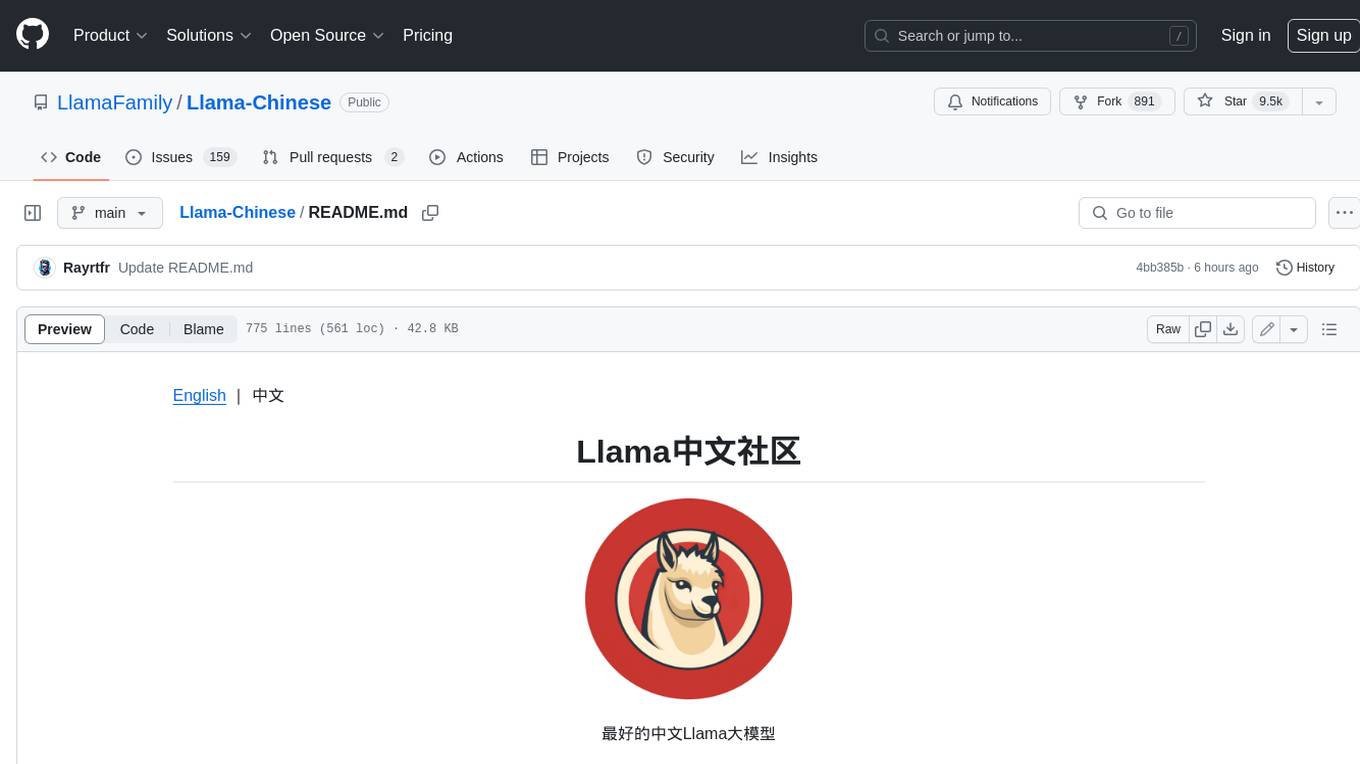
Llama-Chinese
Llama中文社区是一个专注于Llama模型在中文方面的优化和上层建设的高级技术社区。 **已经基于大规模中文数据,从预训练开始对Llama2模型进行中文能力的持续迭代升级【Done】**。**正在对Llama3模型进行中文能力的持续迭代升级【Doing】** 我们热忱欢迎对大模型LLM充满热情的开发者和研究者加入我们的行列。
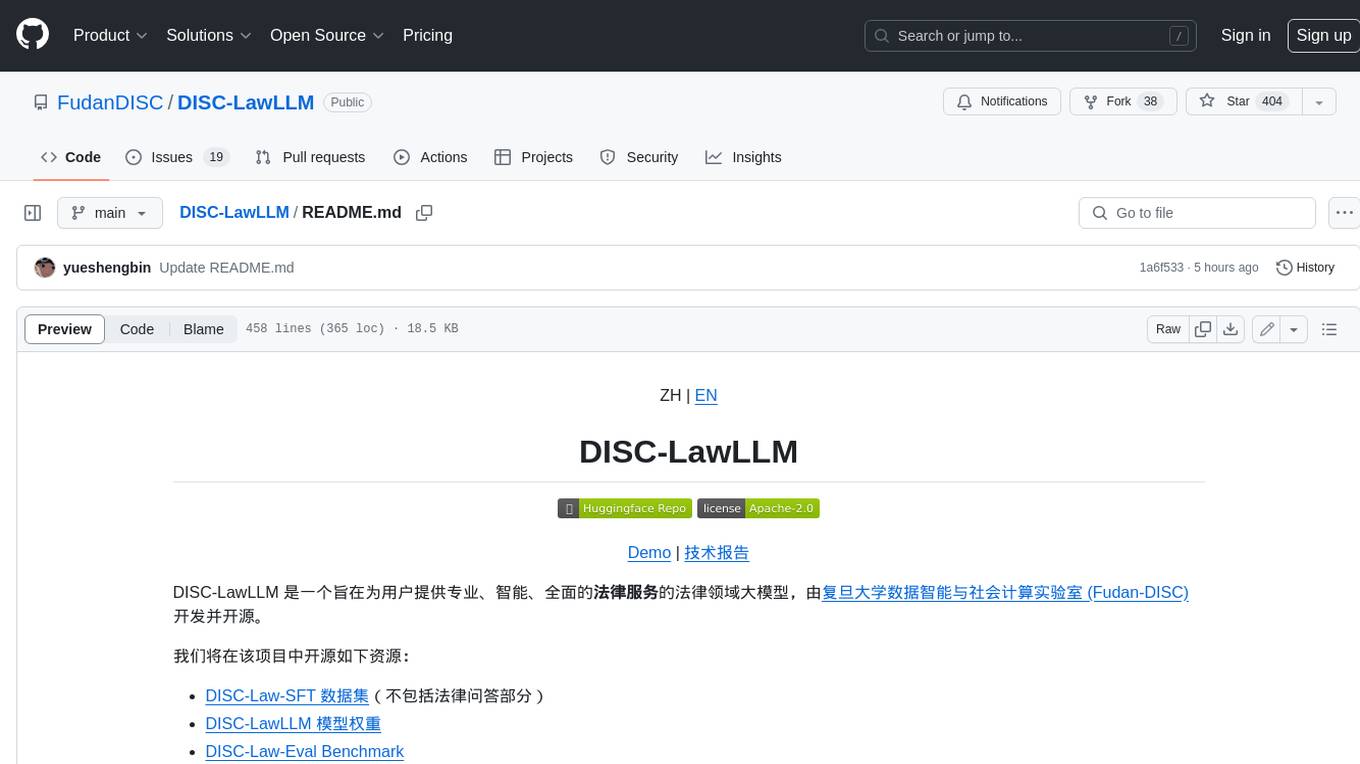
DISC-LawLLM
DISC-LawLLM is a legal domain large model that aims to provide professional, intelligent, and comprehensive **legal services** to users. It is developed and open-sourced by the Data Intelligence and Social Computing Lab (Fudan-DISC) at Fudan University.
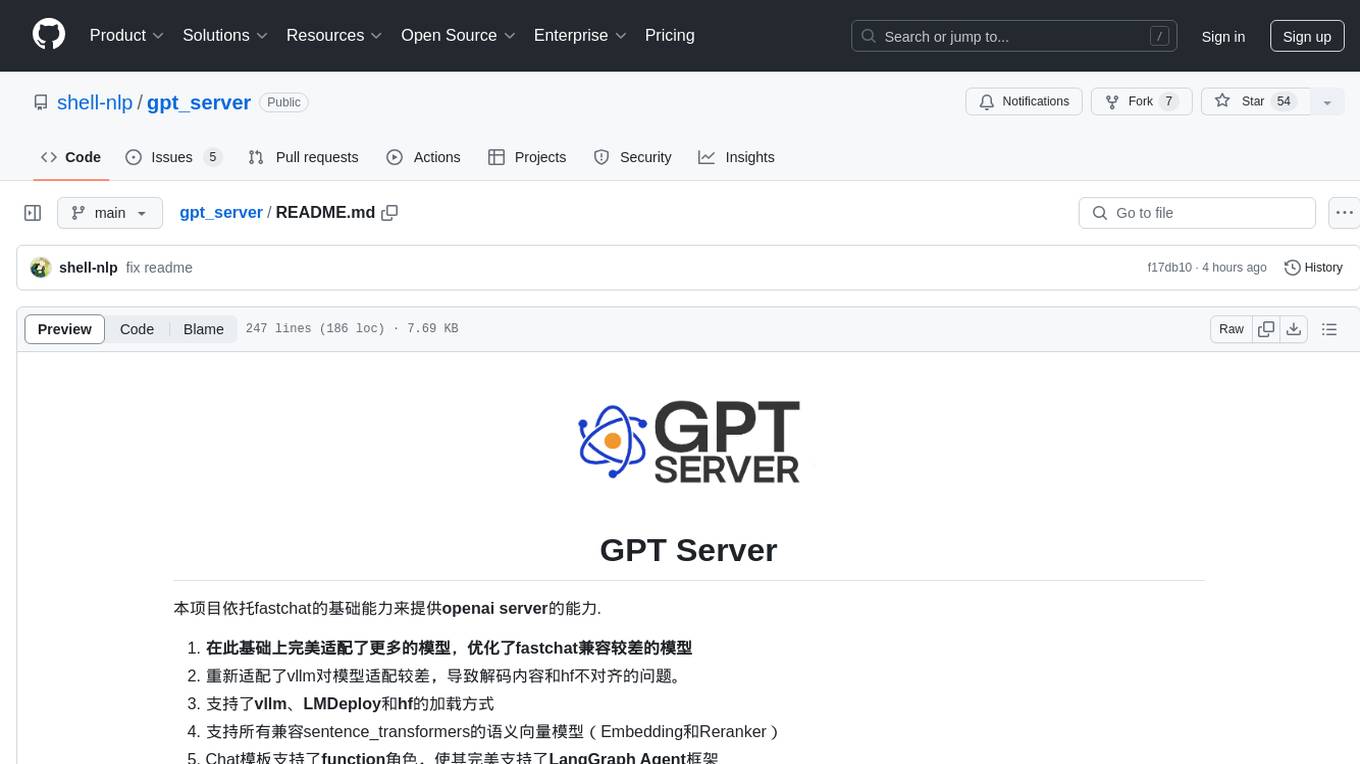
gpt_server
The GPT Server project leverages the basic capabilities of FastChat to provide the capabilities of an openai server. It perfectly adapts more models, optimizes models with poor compatibility in FastChat, and supports loading vllm, LMDeploy, and hf in various ways. It also supports all sentence_transformers compatible semantic vector models, including Chat templates with function roles, Function Calling (Tools) capability, and multi-modal large models. The project aims to reduce the difficulty of model adaptation and project usage, making it easier to deploy the latest models with minimal code changes.
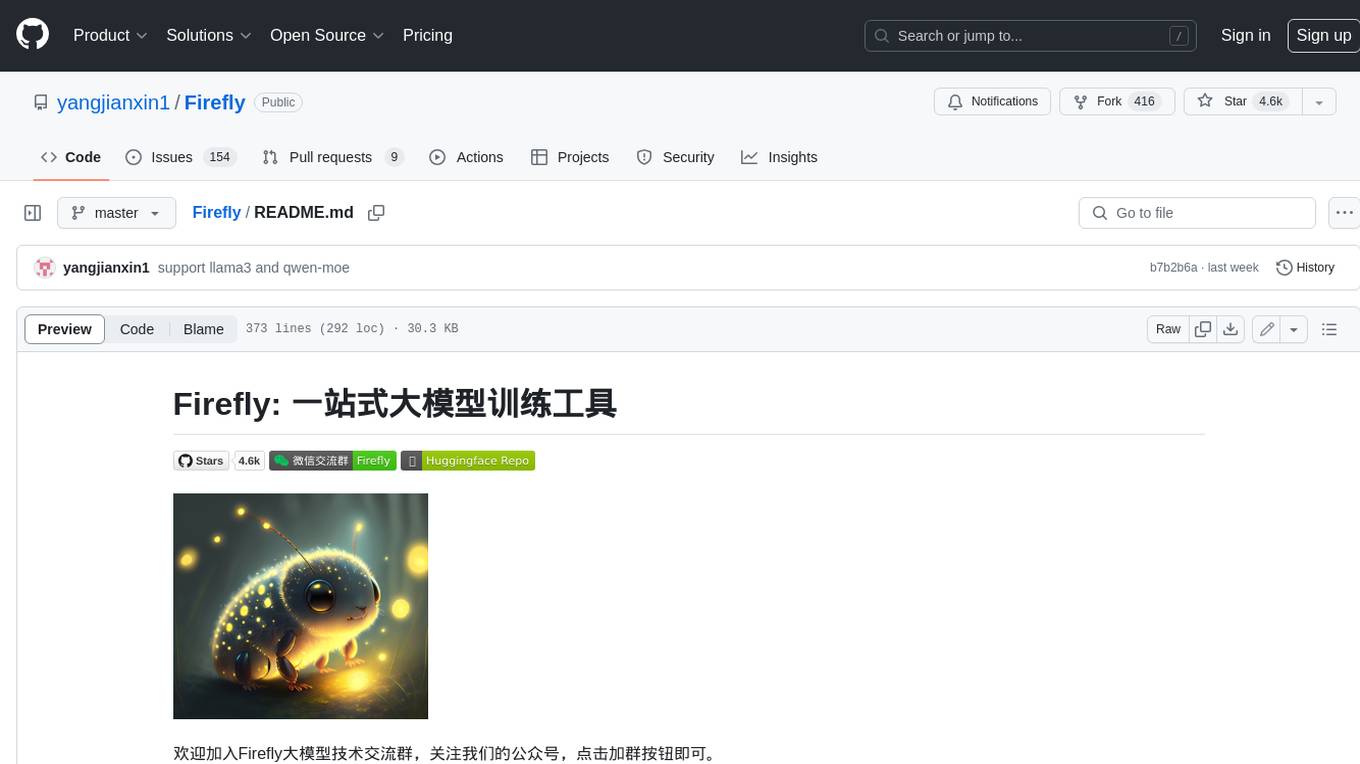
Firefly
Firefly is an open-source large model training project that supports pre-training, fine-tuning, and DPO of mainstream large models. It includes models like Llama3, Gemma, Qwen1.5, MiniCPM, Llama, InternLM, Baichuan, ChatGLM, Yi, Deepseek, Qwen, Orion, Ziya, Xverse, Mistral, Mixtral-8x7B, Zephyr, Vicuna, Bloom, etc. The project supports full-parameter training, LoRA, QLoRA efficient training, and various tasks such as pre-training, SFT, and DPO. Suitable for users with limited training resources, QLoRA is recommended for fine-tuning instructions. The project has achieved good results on the Open LLM Leaderboard with QLoRA training process validation. The latest version has significant updates and adaptations for different chat model templates.
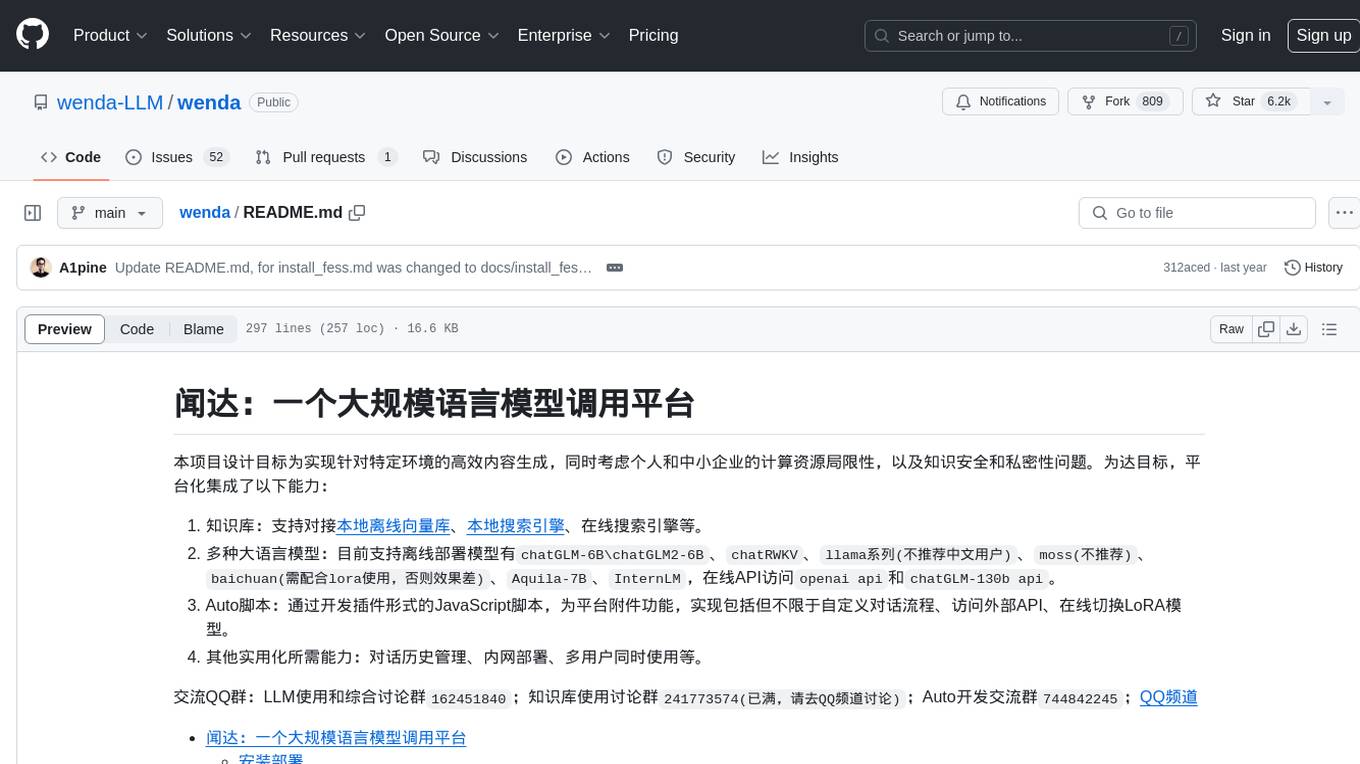
wenda
Wenda is a platform for large-scale language model invocation designed to efficiently generate content for specific environments, considering the limitations of personal and small business computing resources, as well as knowledge security and privacy issues. The platform integrates capabilities such as knowledge base integration, multiple large language models for offline deployment, auto scripts for additional functionality, and other practical capabilities like conversation history management and multi-user simultaneous usage.
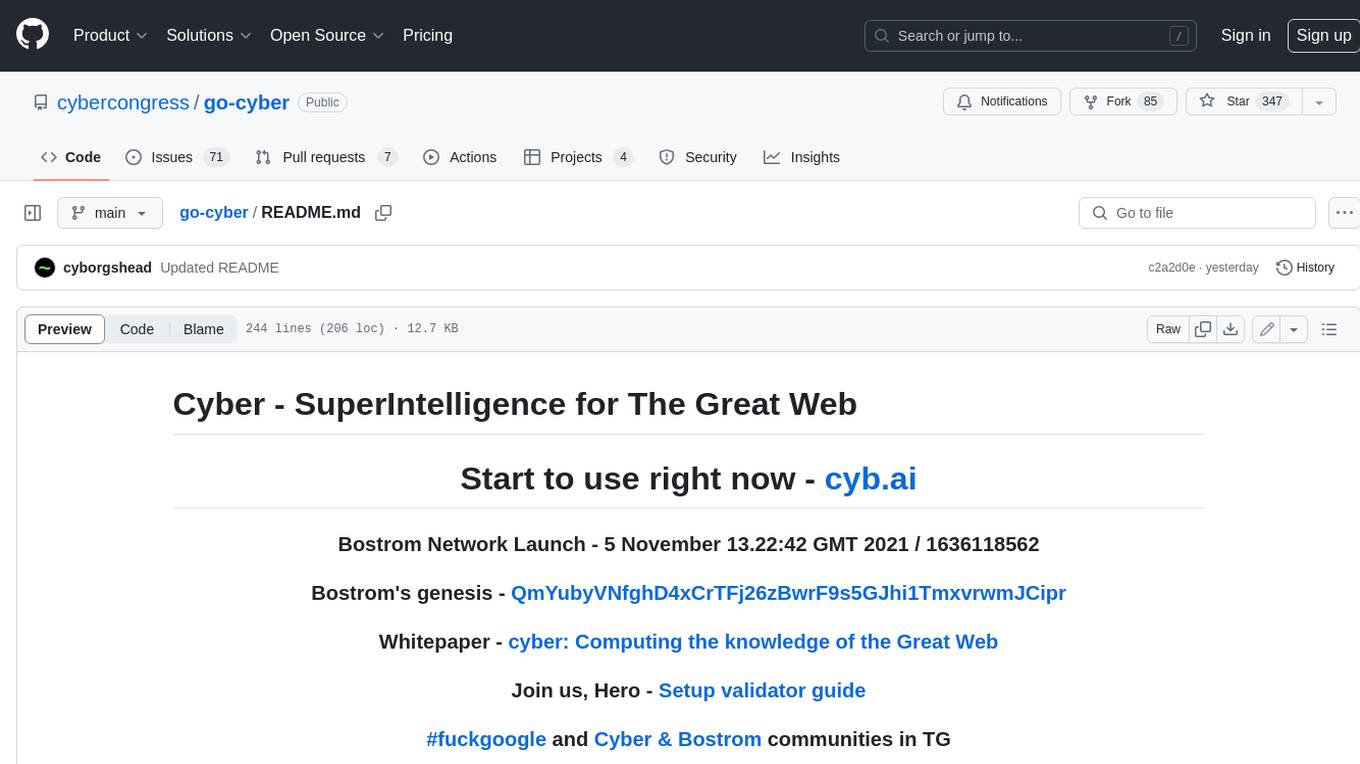
go-cyber
Cyber is a superintelligence protocol that aims to create a decentralized and censorship-resistant internet. It uses a novel consensus mechanism called CometBFT and a knowledge graph to store and process information. Cyber is designed to be scalable, secure, and efficient, and it has the potential to revolutionize the way we interact with the internet.
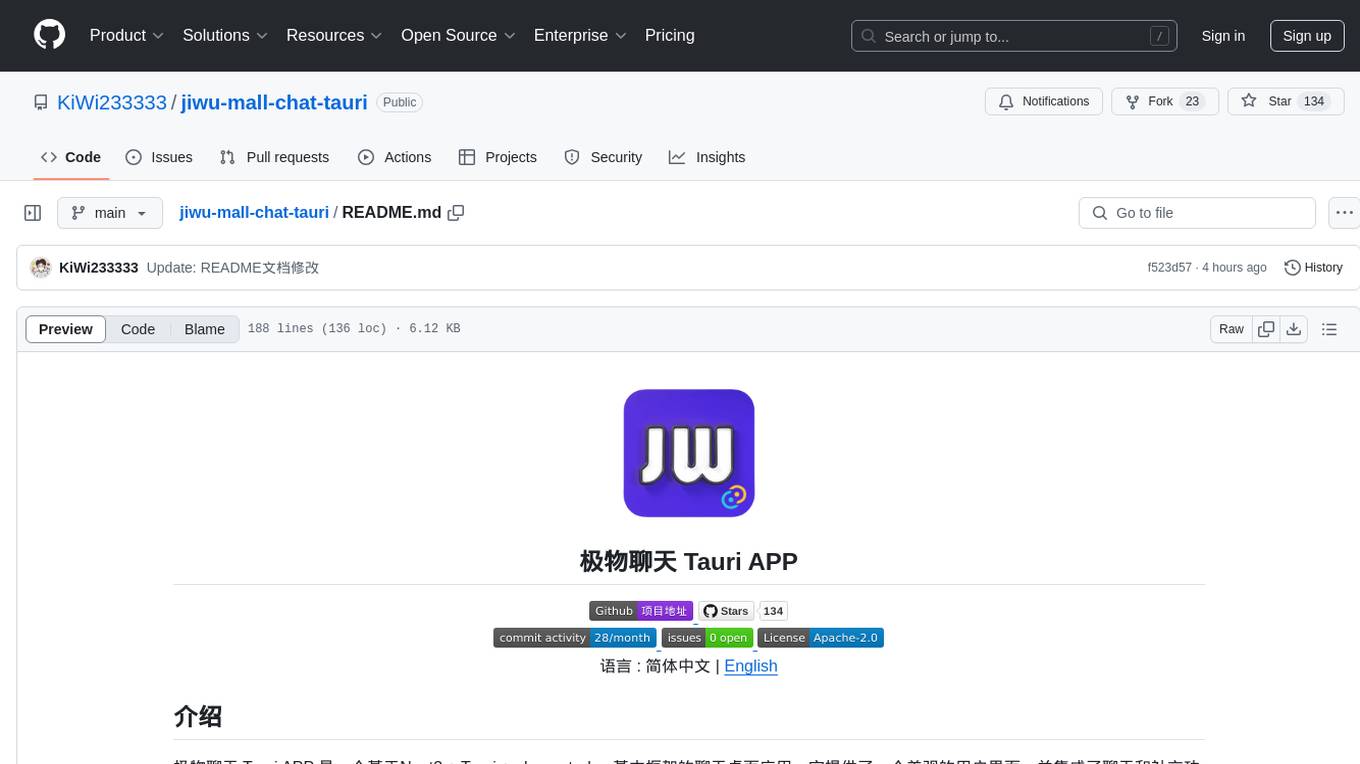
jiwu-mall-chat-tauri
Jiwu Chat Tauri APP is a desktop chat application based on Nuxt3 + Tauri + Element Plus framework. It provides a beautiful user interface with integrated chat and social functions. It also supports AI shopping chat and global dark mode. Users can engage in real-time chat, share updates, and interact with AI customer service through this application.
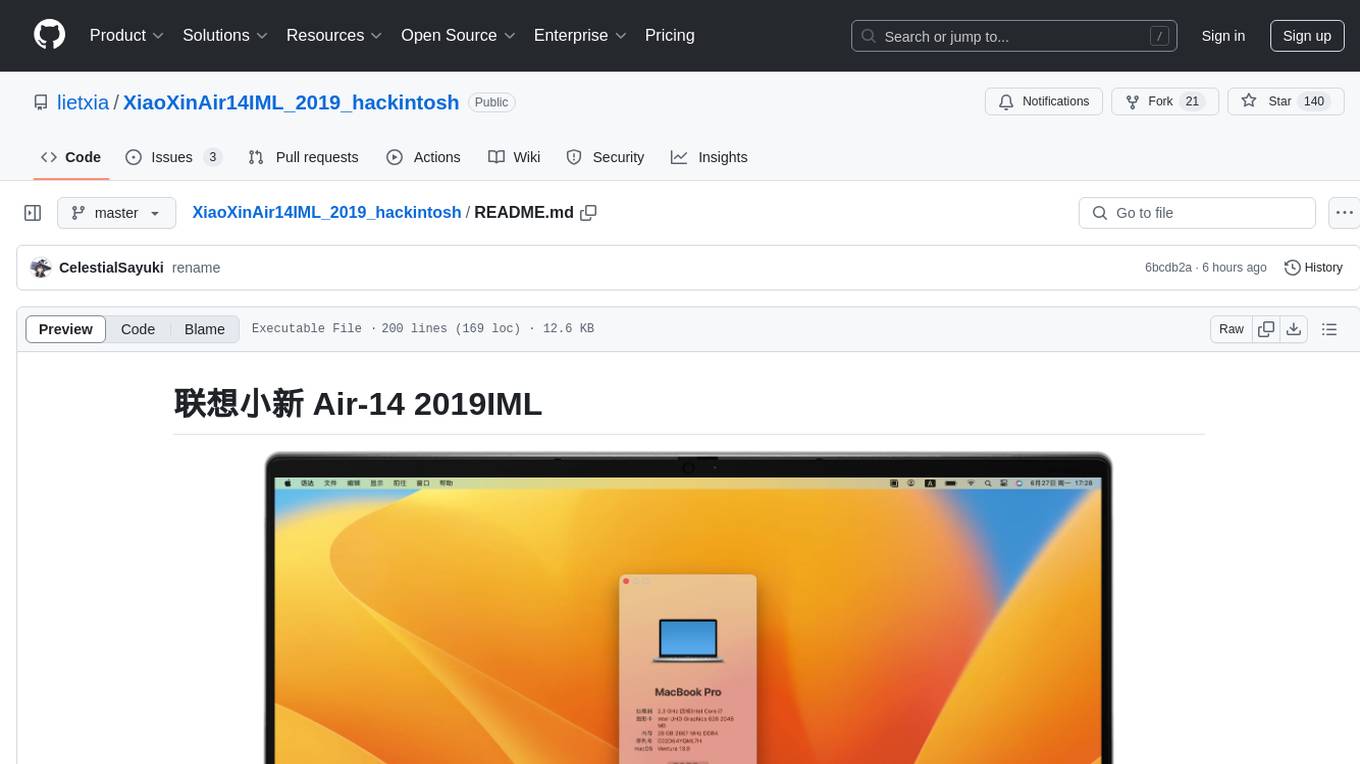
XiaoXinAir14IML_2019_hackintosh
XiaoXinAir14IML_2019_hackintosh is a repository dedicated to enabling macOS installation on Lenovo XiaoXin Air-14 IML 2019 laptops. The repository provides detailed information on the hardware specifications, supported systems, BIOS versions, related models, installation methods, updates, patches, and recommended settings. It also includes tools and guides for BIOS modifications, enabling high-resolution display settings, Bluetooth synchronization between macOS and Windows 10, voltage adjustments for efficiency, and experimental support for YogaSMC. The repository offers solutions for various issues like sleep support, sound card emulation, and battery information. It acknowledges the contributions of developers and tools like OpenCore, itlwm, VoodooI2C, and ALCPlugFix.
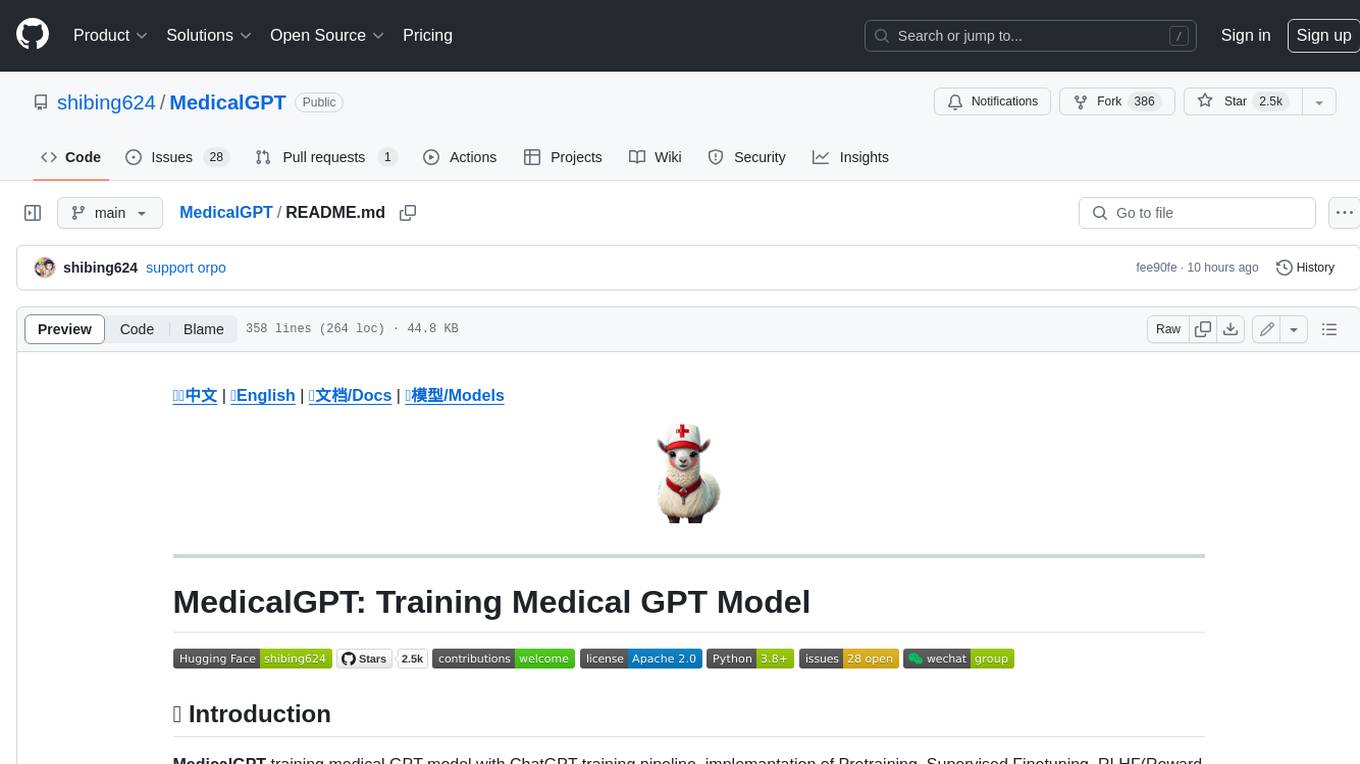
MedicalGPT
MedicalGPT is a training medical GPT model with ChatGPT training pipeline, implement of Pretraining, Supervised Finetuning, RLHF(Reward Modeling and Reinforcement Learning) and DPO(Direct Preference Optimization).
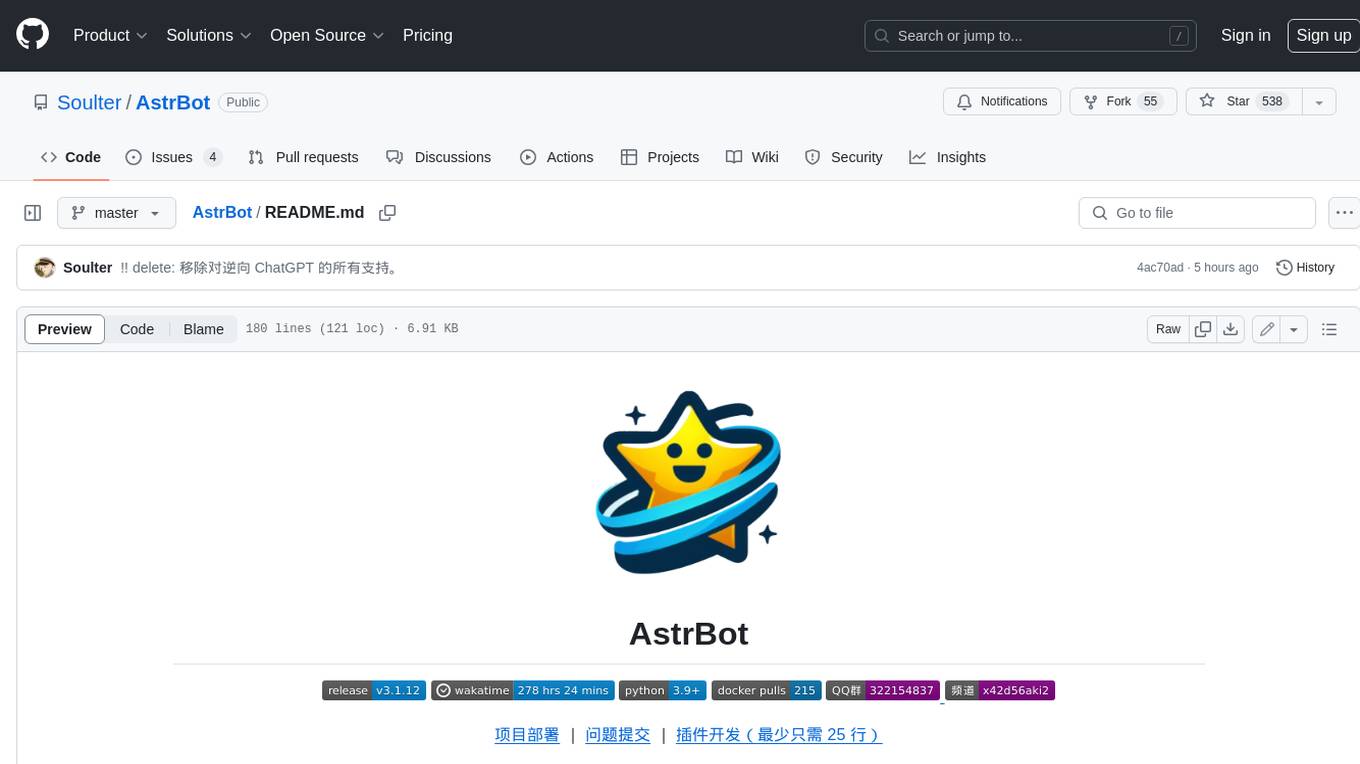
AstrBot
AstrBot is a powerful and versatile tool that leverages the capabilities of large language models (LLMs) like GPT-3, GPT-3.5, and GPT-4 to enhance communication and automate tasks. It seamlessly integrates with popular messaging platforms such as QQ, QQ Channel, and Telegram, enabling users to harness the power of AI within their daily conversations and workflows.
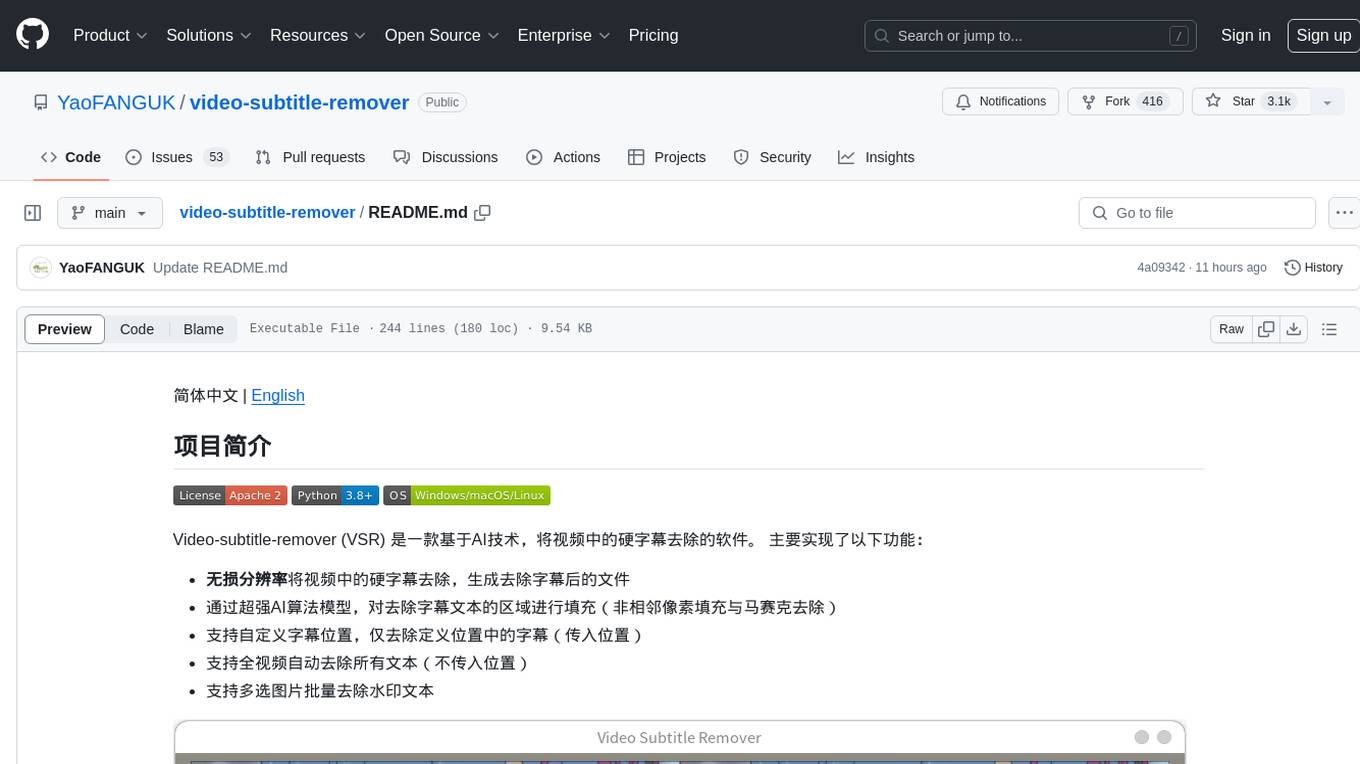
video-subtitle-remover
Video-subtitle-remover (VSR) is a software based on AI technology that removes hard subtitles from videos. It achieves the following functions: - Lossless resolution: Remove hard subtitles from videos, generate files with subtitles removed - Fill the region of removed subtitles using a powerful AI algorithm model (non-adjacent pixel filling and mosaic removal) - Support custom subtitle positions, only remove subtitles in defined positions (input position) - Support automatic removal of all text in the entire video (no input position required) - Support batch removal of watermark text from multiple images.
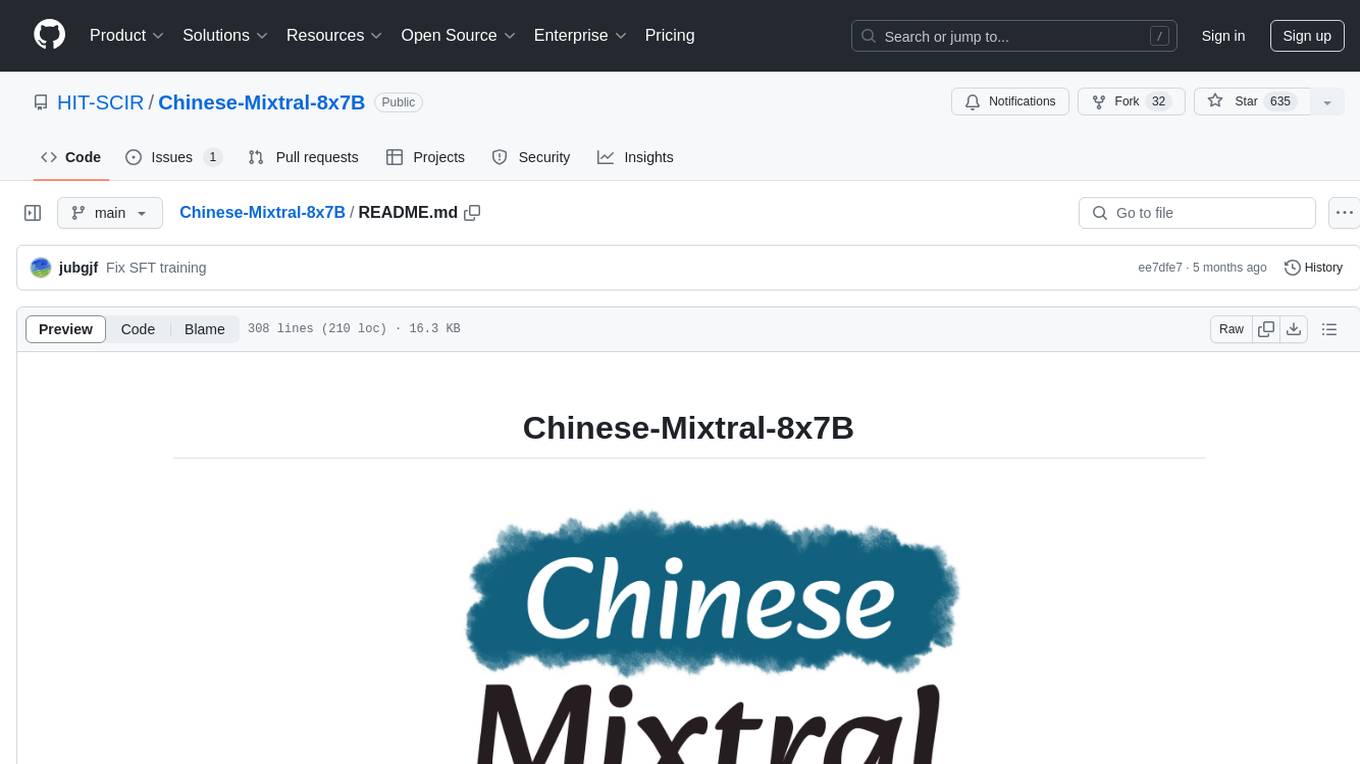
Chinese-Mixtral-8x7B
Chinese-Mixtral-8x7B is an open-source project based on Mistral's Mixtral-8x7B model for incremental pre-training of Chinese vocabulary, aiming to advance research on MoE models in the Chinese natural language processing community. The expanded vocabulary significantly improves the model's encoding and decoding efficiency for Chinese, and the model is pre-trained incrementally on a large-scale open-source corpus, enabling it with powerful Chinese generation and comprehension capabilities. The project includes a large model with expanded Chinese vocabulary and incremental pre-training code.
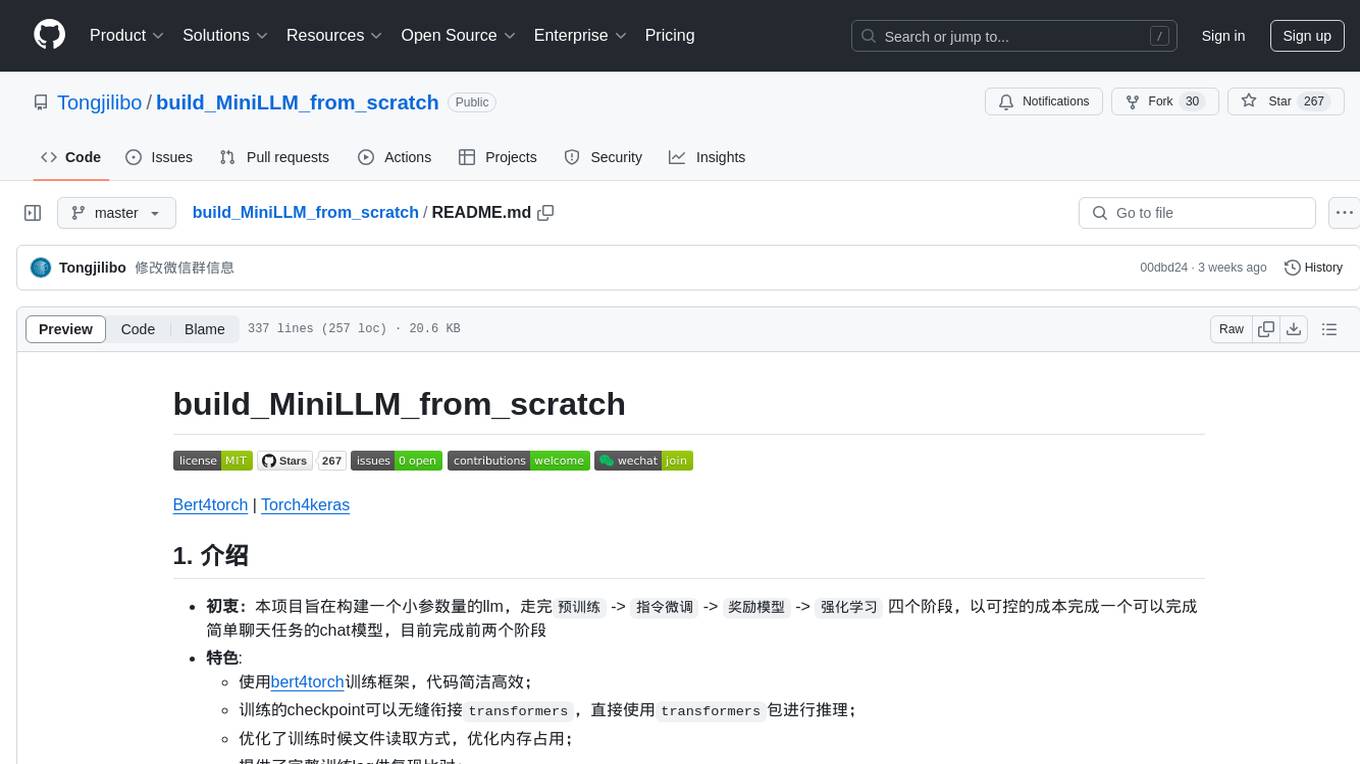
build_MiniLLM_from_scratch
This repository aims to build a low-parameter LLM model through pretraining, fine-tuning, model rewarding, and reinforcement learning stages to create a chat model capable of simple conversation tasks. It features using the bert4torch training framework, seamless integration with transformers package for inference, optimized file reading during training to reduce memory usage, providing complete training logs for reproducibility, and the ability to customize robot attributes. The chat model supports multi-turn conversations. The trained model currently only supports basic chat functionality due to limitations in corpus size, model scale, SFT corpus size, and quality.
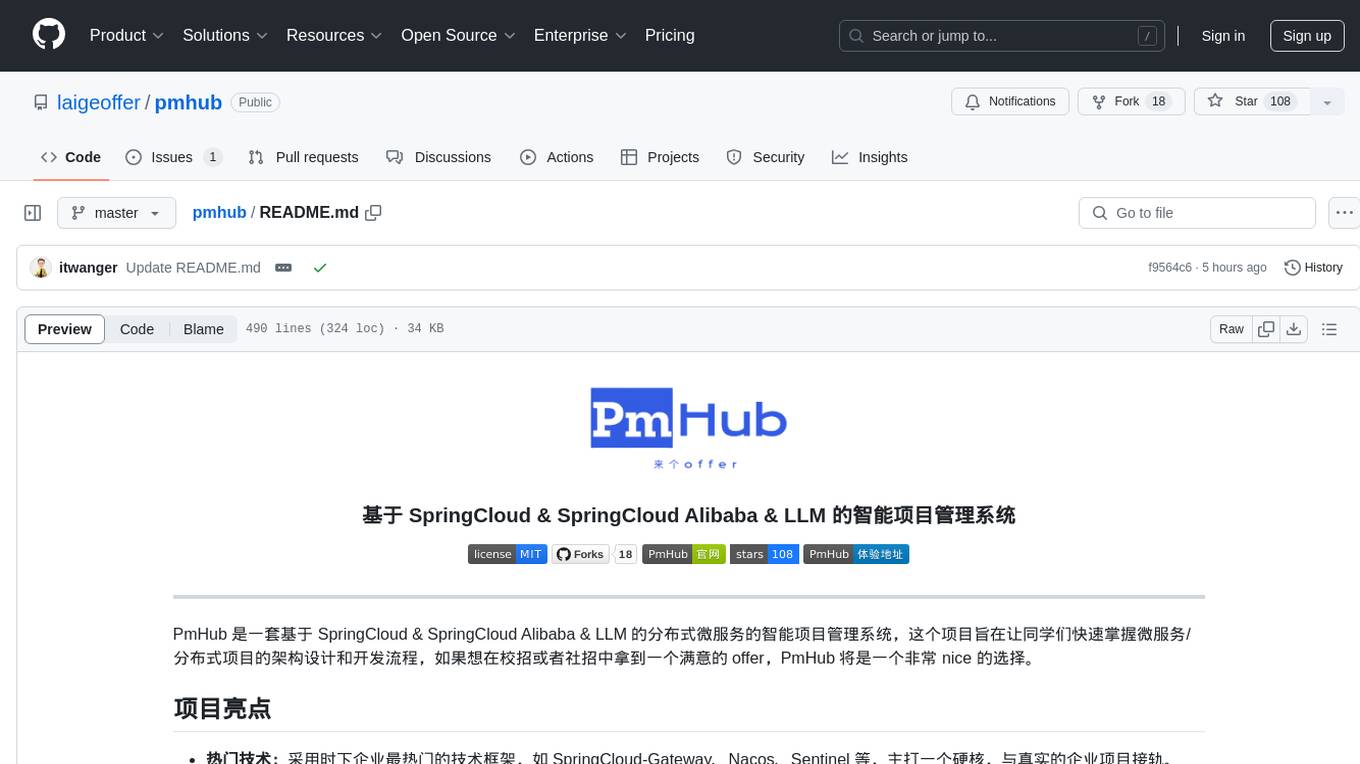
pmhub
PmHub is a smart project management system based on SpringCloud, SpringCloud Alibaba, and LLM. It aims to help students quickly grasp the architecture design and development process of microservices/distributed projects. PmHub provides a platform for students to experience the transformation from monolithic to microservices architecture, understand the pros and cons of both architectures, and prepare for job interviews. It offers popular technologies like SpringCloud-Gateway, Nacos, Sentinel, and provides high-quality code, continuous integration, product design documents, and an enterprise workflow system. PmHub is suitable for beginners and advanced learners who want to master core knowledge of microservices/distributed projects.
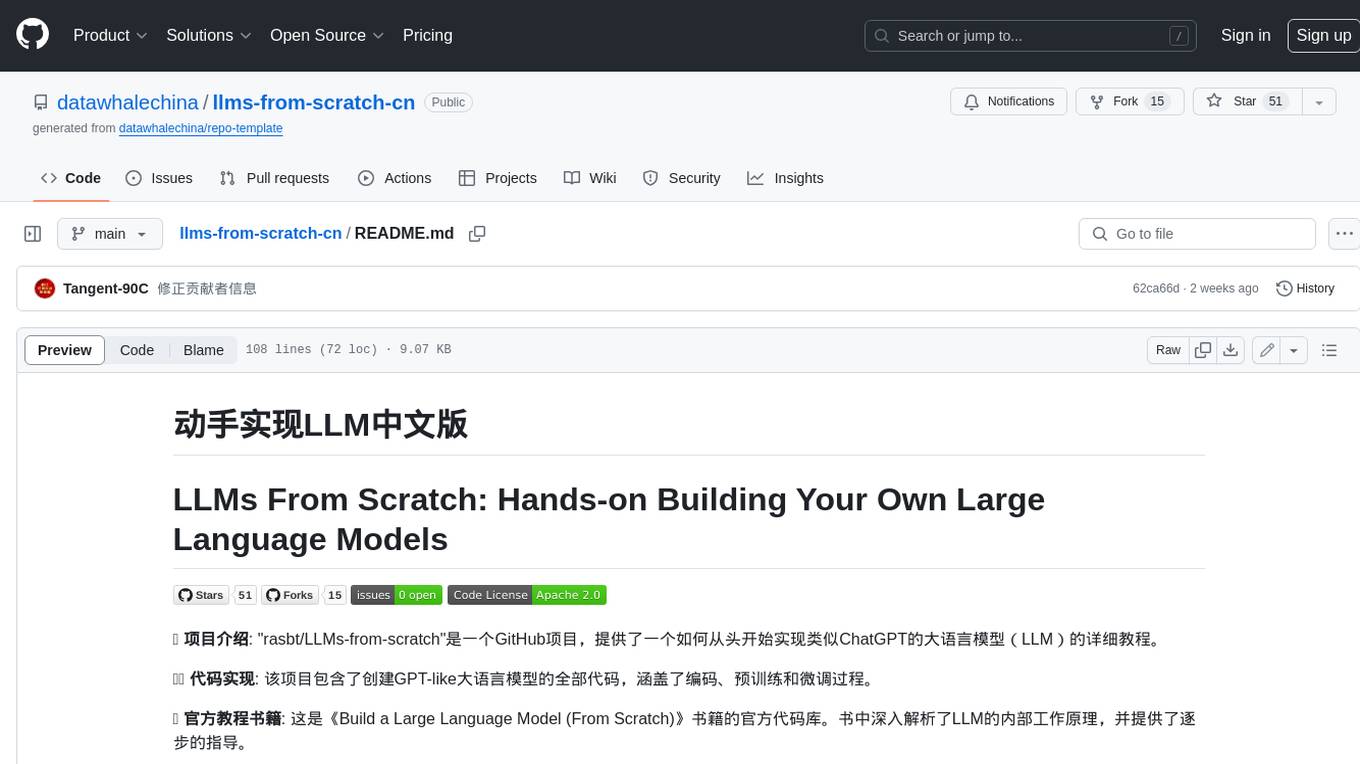
llms-from-scratch-cn
This repository provides a detailed tutorial on how to build your own large language model (LLM) from scratch. It includes all the code necessary to create a GPT-like LLM, covering the encoding, pre-training, and fine-tuning processes. The tutorial is written in a clear and concise style, with plenty of examples and illustrations to help you understand the concepts involved. It is suitable for developers and researchers with some programming experience who are interested in learning more about LLMs and how to build them.
For similar tasks

MiniCPM
MiniCPM is a series of open-source large models on the client side jointly developed by Face Intelligence and Tsinghua University Natural Language Processing Laboratory. The main language model MiniCPM-2B has only 2.4 billion (2.4B) non-word embedding parameters, with a total of 2.7B parameters. - After SFT, MiniCPM-2B performs similarly to Mistral-7B on public comprehensive evaluation sets (better in Chinese, mathematics, and code capabilities), and outperforms models such as Llama2-13B, MPT-30B, and Falcon-40B overall. - After DPO, MiniCPM-2B also surpasses many representative open-source large models such as Llama2-70B-Chat, Vicuna-33B, Mistral-7B-Instruct-v0.1, and Zephyr-7B-alpha on the current evaluation set MTBench, which is closest to the user experience. - Based on MiniCPM-2B, a multi-modal large model MiniCPM-V 2.0 on the client side is constructed, which achieves the best performance of models below 7B in multiple test benchmarks, and surpasses larger parameter scale models such as Qwen-VL-Chat 9.6B, CogVLM-Chat 17.4B, and Yi-VL 34B on the OpenCompass leaderboard. MiniCPM-V 2.0 also demonstrates leading OCR capabilities, approaching Gemini Pro in scene text recognition capabilities. - After Int4 quantization, MiniCPM can be deployed and inferred on mobile phones, with a streaming output speed slightly higher than human speech speed. MiniCPM-V also directly runs through the deployment of multi-modal large models on mobile phones. - A single 1080/2080 can efficiently fine-tune parameters, and a single 3090/4090 can fully fine-tune parameters. A single machine can continuously train MiniCPM, and the secondary development cost is relatively low.

ai-guide
This guide is dedicated to Large Language Models (LLMs) that you can run on your home computer. It assumes your PC is a lower-end, non-gaming setup.

onnxruntime-genai
ONNX Runtime Generative AI is a library that provides the generative AI loop for ONNX models, including inference with ONNX Runtime, logits processing, search and sampling, and KV cache management. Users can call a high level `generate()` method, or run each iteration of the model in a loop. It supports greedy/beam search and TopP, TopK sampling to generate token sequences, has built in logits processing like repetition penalties, and allows for easy custom scoring.
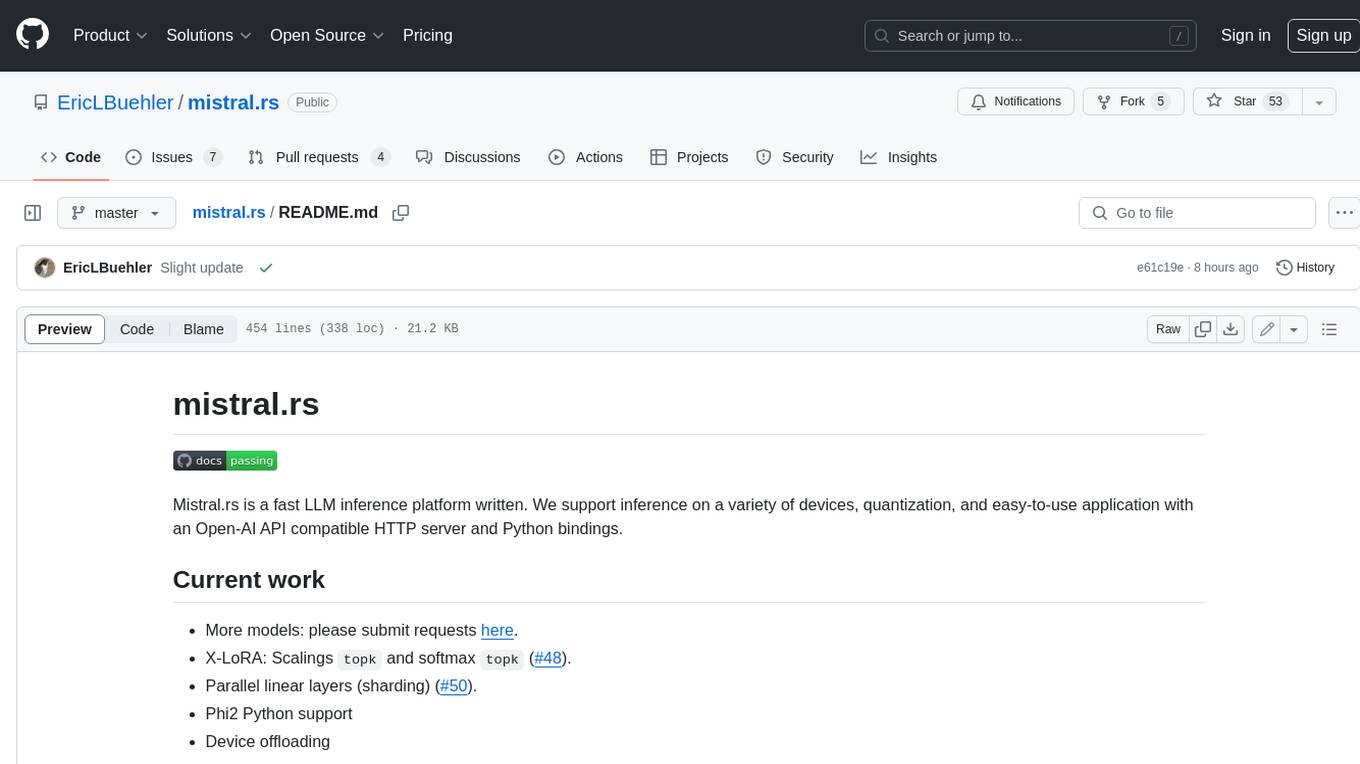
mistral.rs
Mistral.rs is a fast LLM inference platform written in Rust. We support inference on a variety of devices, quantization, and easy-to-use application with an Open-AI API compatible HTTP server and Python bindings.
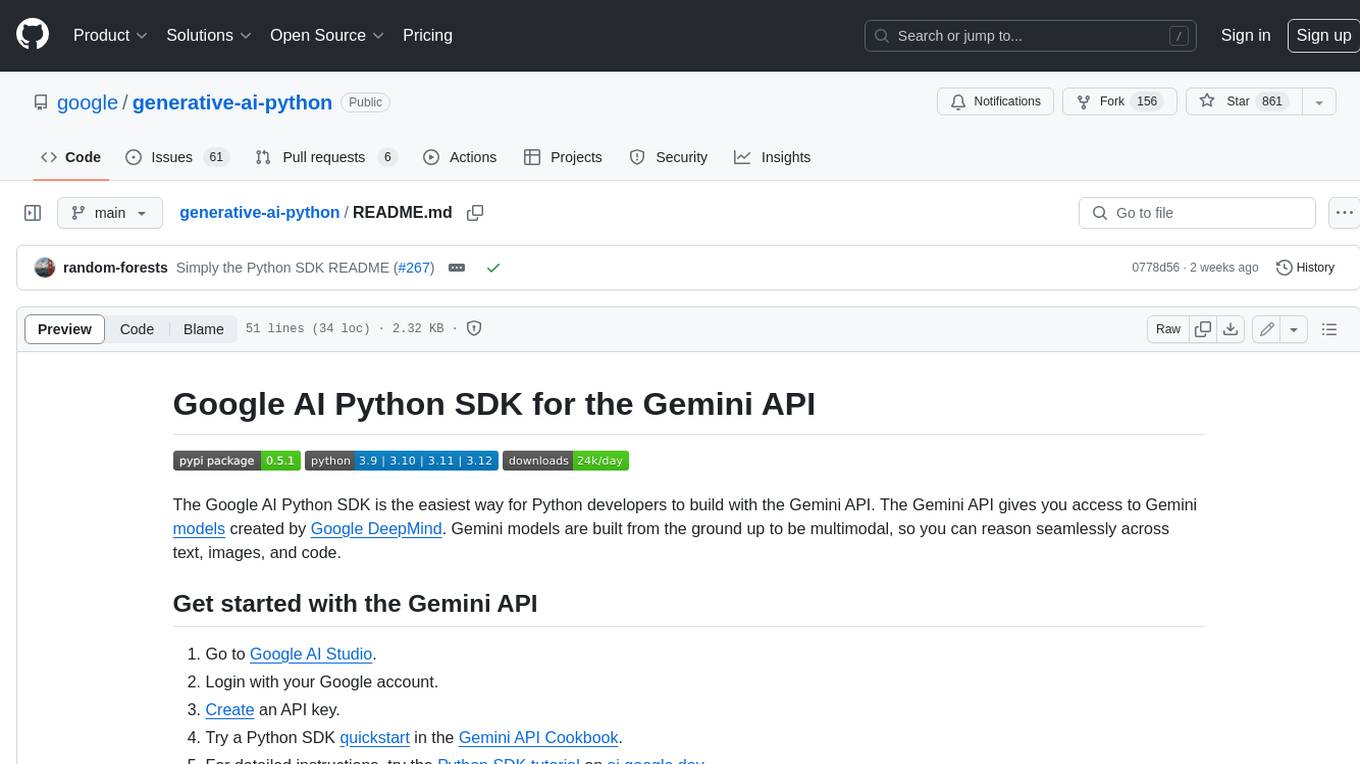
generative-ai-python
The Google AI Python SDK is the easiest way for Python developers to build with the Gemini API. The Gemini API gives you access to Gemini models created by Google DeepMind. Gemini models are built from the ground up to be multimodal, so you can reason seamlessly across text, images, and code.
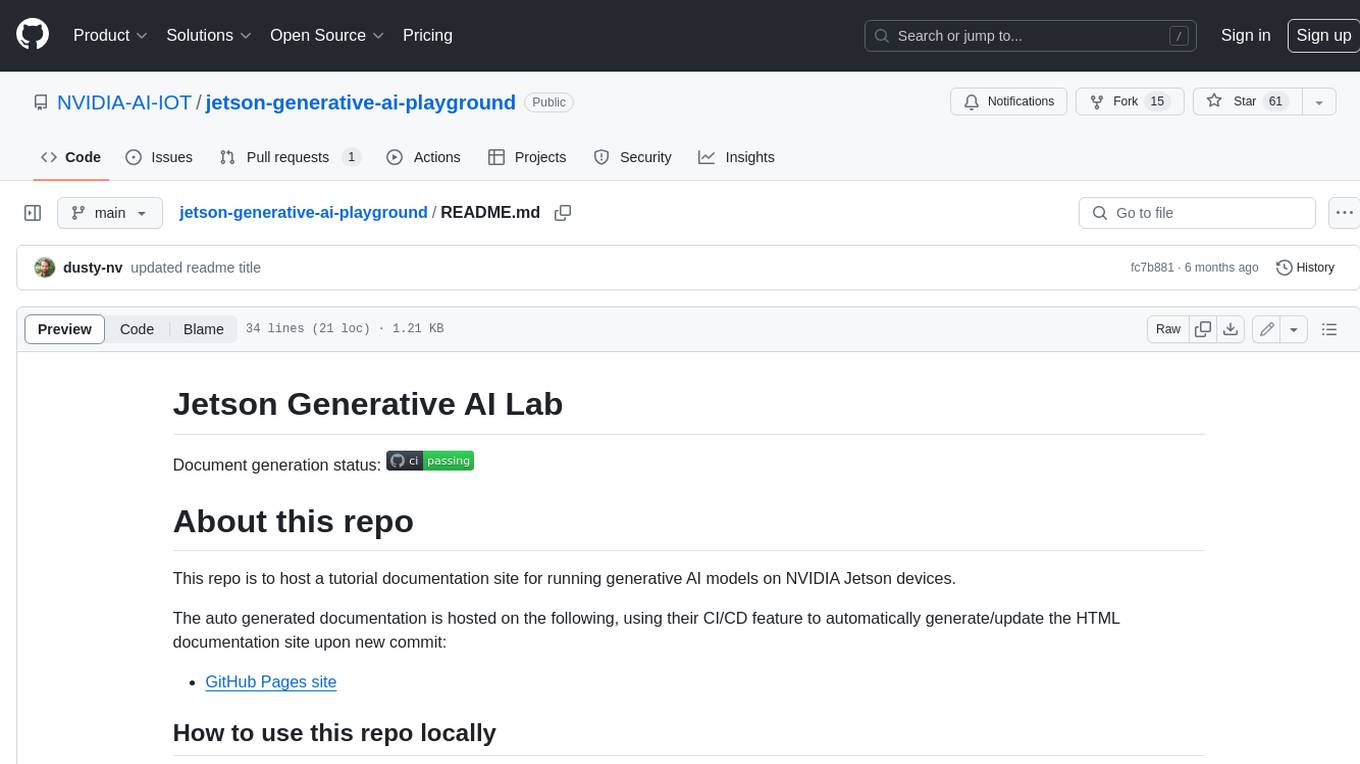
jetson-generative-ai-playground
This repo hosts tutorial documentation for running generative AI models on NVIDIA Jetson devices. The documentation is auto-generated and hosted on GitHub Pages using their CI/CD feature to automatically generate/update the HTML documentation site upon new commits.
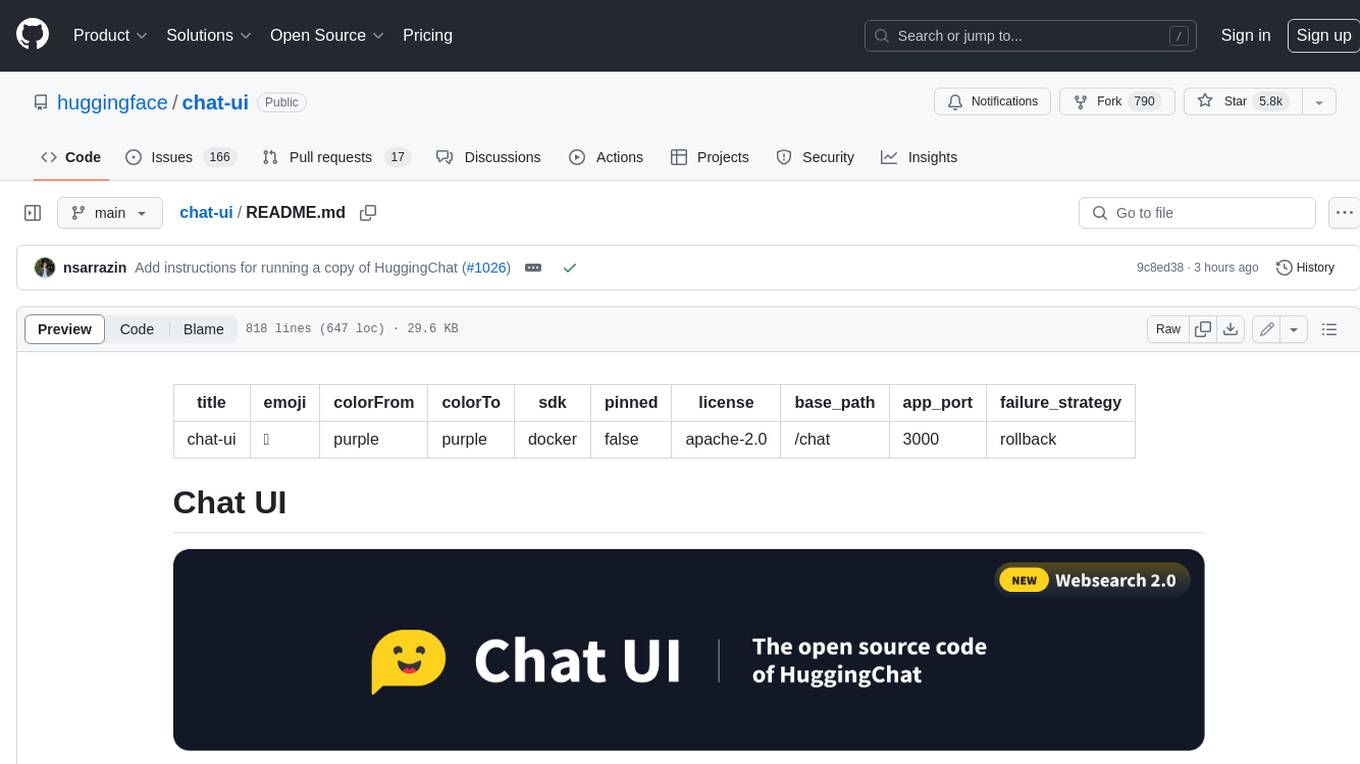
chat-ui
A chat interface using open source models, eg OpenAssistant or Llama. It is a SvelteKit app and it powers the HuggingChat app on hf.co/chat.
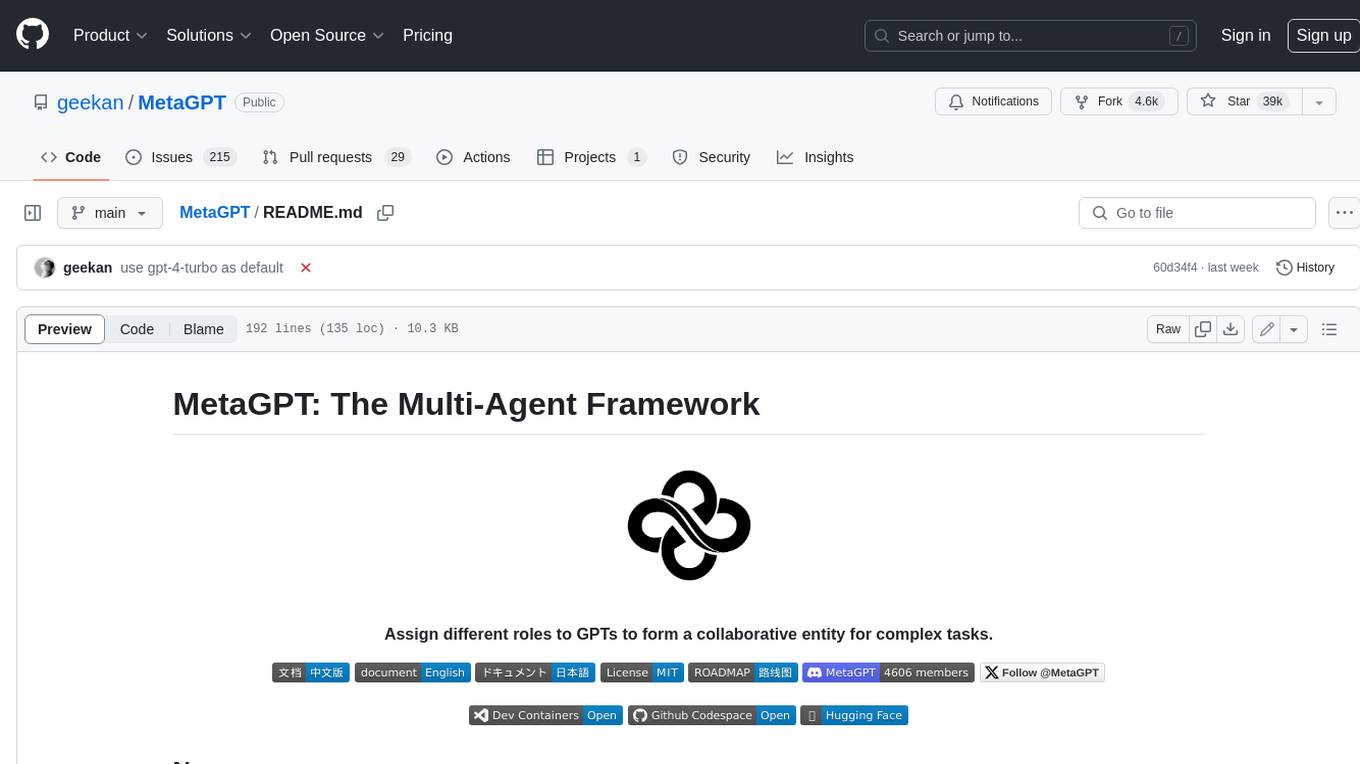
MetaGPT
MetaGPT is a multi-agent framework that enables GPT to work in a software company, collaborating to tackle more complex tasks. It assigns different roles to GPTs to form a collaborative entity for complex tasks. MetaGPT takes a one-line requirement as input and outputs user stories, competitive analysis, requirements, data structures, APIs, documents, etc. Internally, MetaGPT includes product managers, architects, project managers, and engineers. It provides the entire process of a software company along with carefully orchestrated SOPs. MetaGPT's core philosophy is "Code = SOP(Team)", materializing SOP and applying it to teams composed of LLMs.
For similar jobs
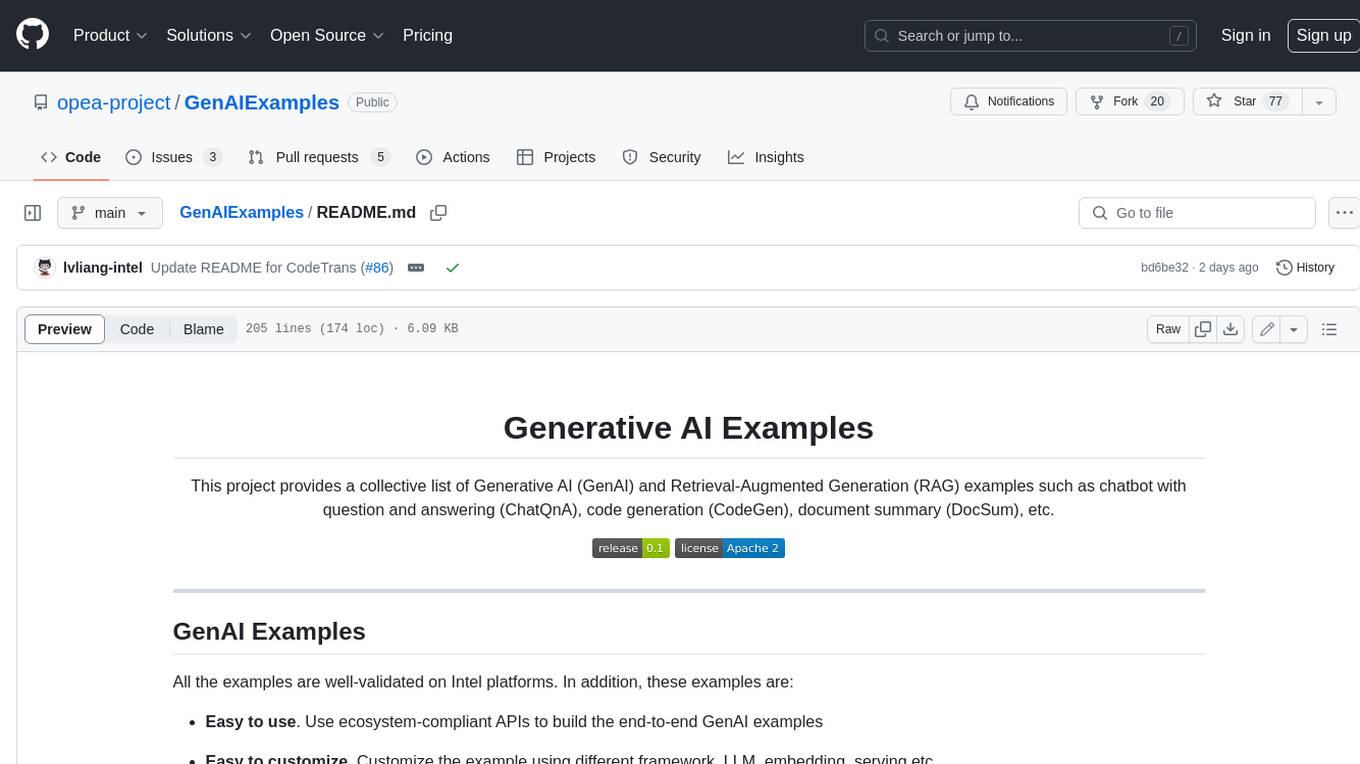
GenAIExamples
This project provides a collective list of Generative AI (GenAI) and Retrieval-Augmented Generation (RAG) examples such as chatbot with question and answering (ChatQnA), code generation (CodeGen), document summary (DocSum), etc.
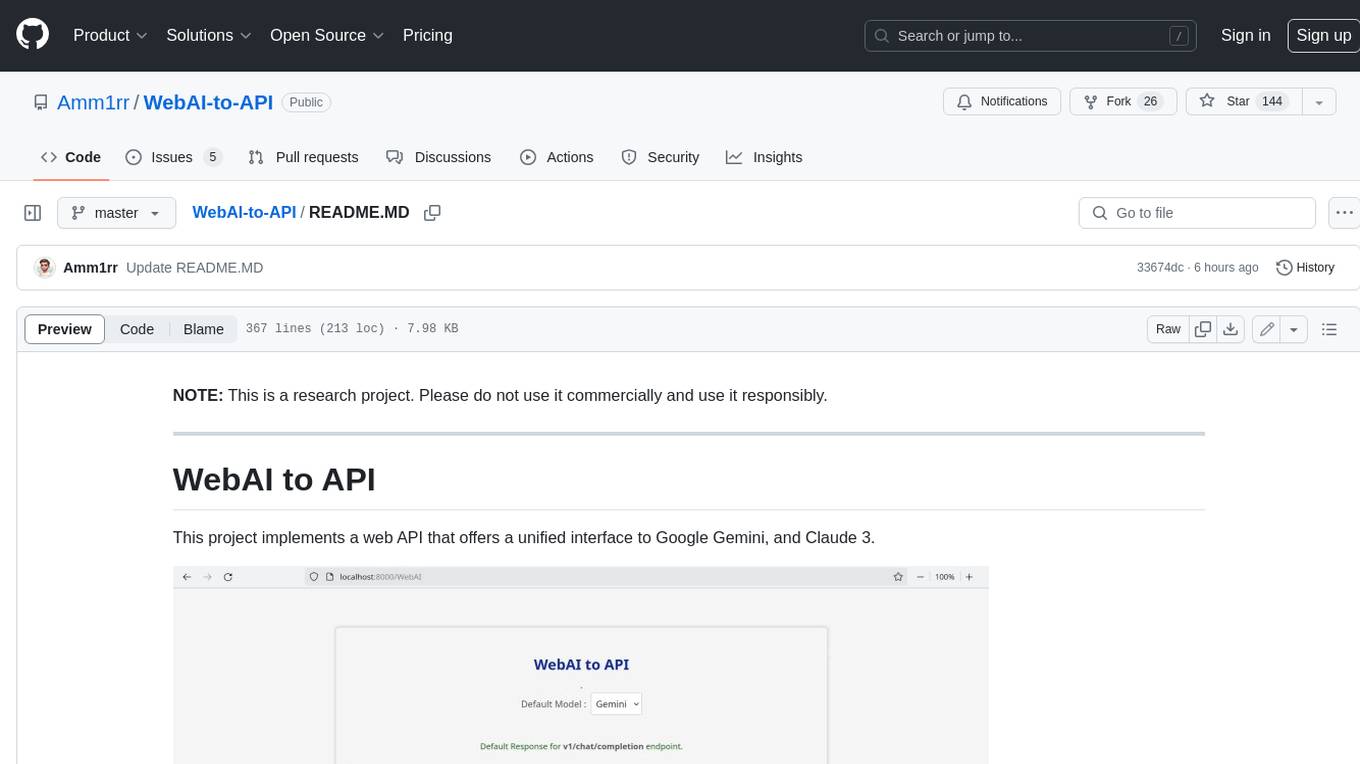
WebAI-to-API
This project implements a web API that offers a unified interface to Google Gemini and Claude 3. It provides a self-hosted, lightweight, and scalable solution for accessing these AI models through a streaming API. The API supports both Claude and Gemini models, allowing users to interact with them in real-time. The project includes a user-friendly web UI for configuration and documentation, making it easy to get started and explore the capabilities of the API.
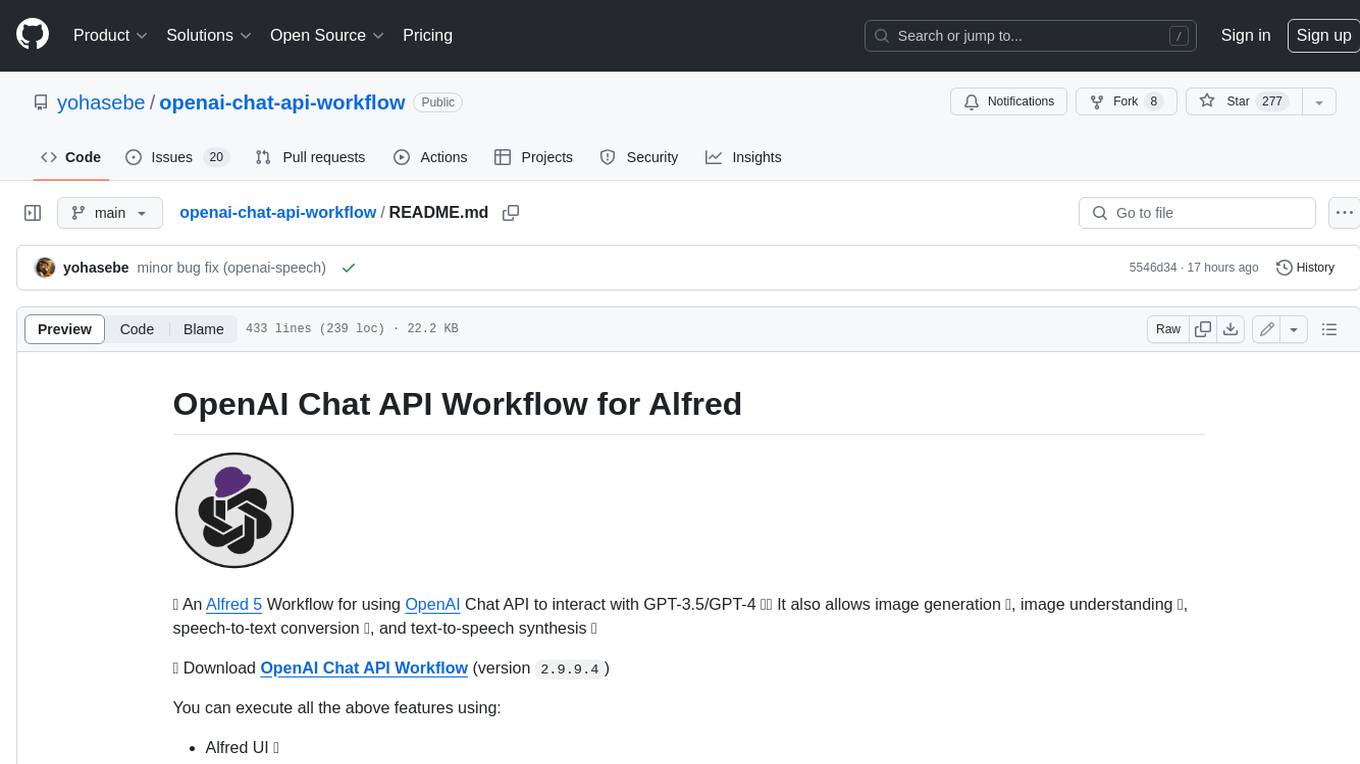
openai-chat-api-workflow
**OpenAI Chat API Workflow for Alfred** An Alfred 5 Workflow for using OpenAI Chat API to interact with GPT-3.5/GPT-4 🤖💬 It also allows image generation 🖼️, image understanding 👀, speech-to-text conversion 🎤, and text-to-speech synthesis 🔈 **Features:** * Execute all features using Alfred UI, selected text, or a dedicated web UI * Web UI is constructed by the workflow and runs locally on your Mac 💻 * API call is made directly between the workflow and OpenAI, ensuring your chat messages are not shared online with anyone other than OpenAI 🔒 * OpenAI does not use the data from the API Platform for training 🚫 * Export chat data to a simple JSON format external file 📄 * Continue the chat by importing the exported data later 🔄
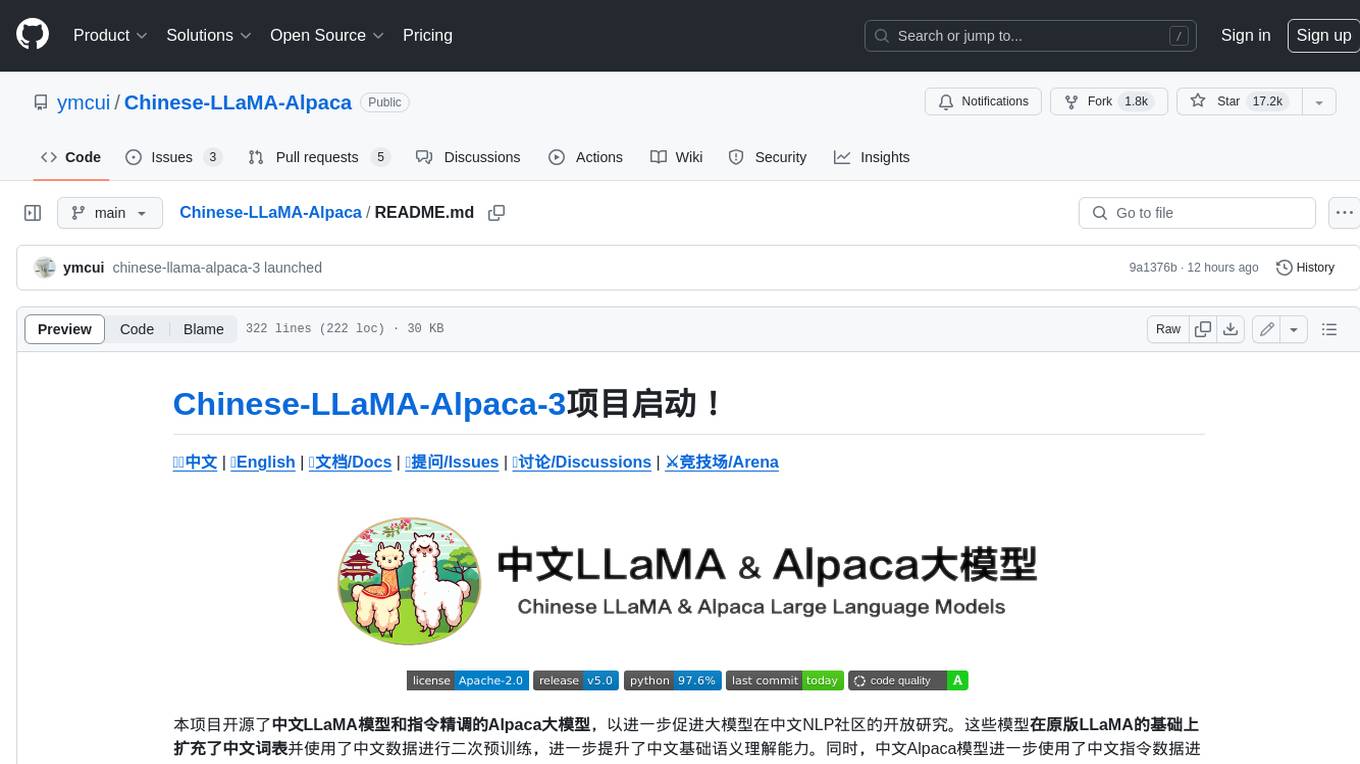
Chinese-LLaMA-Alpaca
This project open sources the **Chinese LLaMA model and the Alpaca large model fine-tuned with instructions**, to further promote the open research of large models in the Chinese NLP community. These models **extend the Chinese vocabulary based on the original LLaMA** and use Chinese data for secondary pre-training, further enhancing the basic Chinese semantic understanding ability. At the same time, the Chinese Alpaca model further uses Chinese instruction data for fine-tuning, significantly improving the model's understanding and execution of instructions.
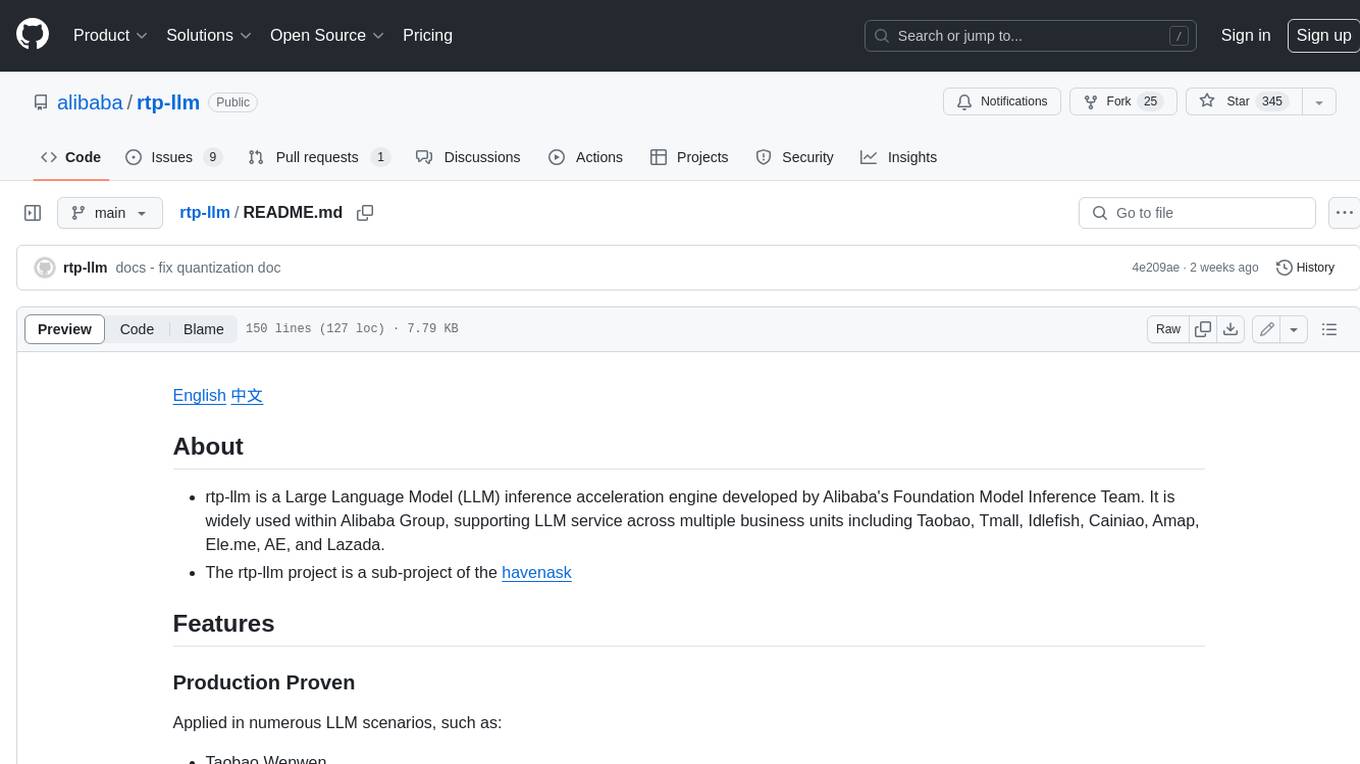
rtp-llm
**rtp-llm** is a Large Language Model (LLM) inference acceleration engine developed by Alibaba's Foundation Model Inference Team. It is widely used within Alibaba Group, supporting LLM service across multiple business units including Taobao, Tmall, Idlefish, Cainiao, Amap, Ele.me, AE, and Lazada. The rtp-llm project is a sub-project of the havenask.
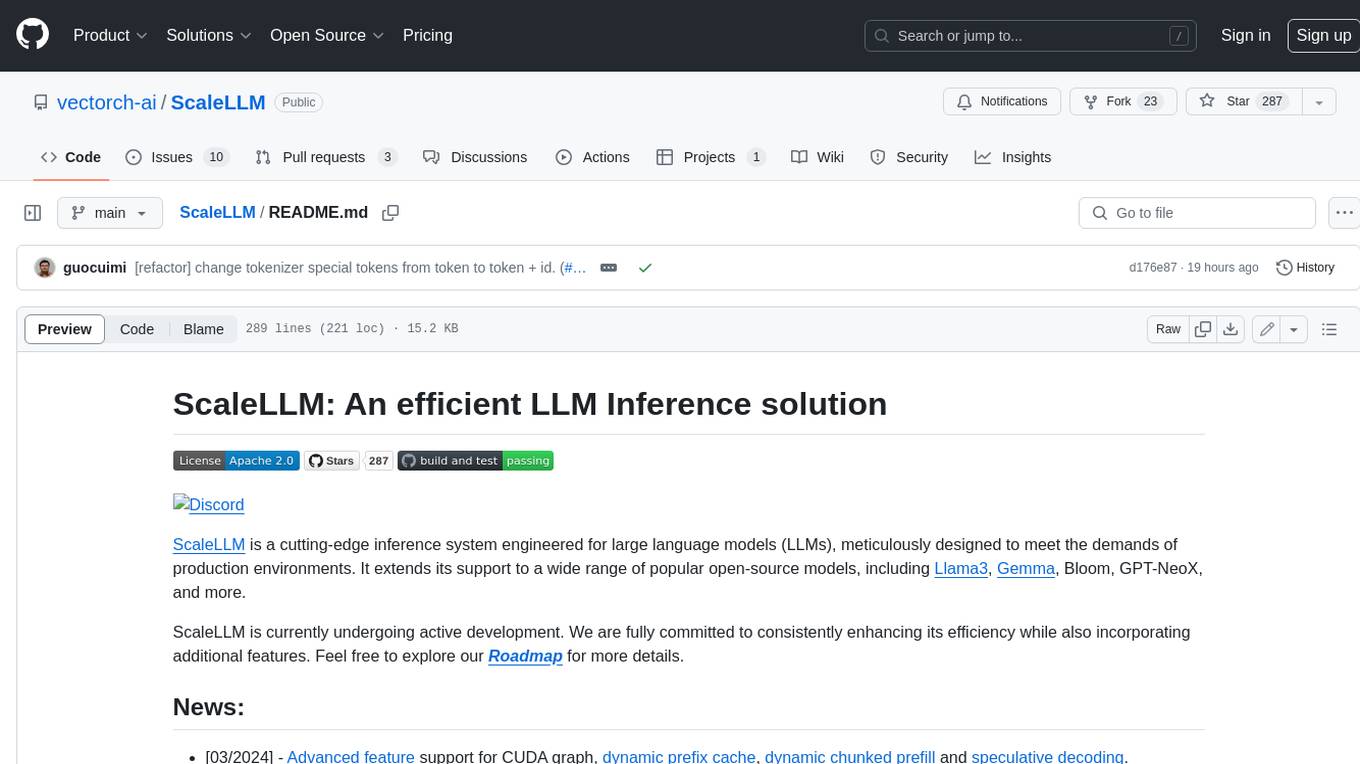
ScaleLLM
ScaleLLM is a cutting-edge inference system engineered for large language models (LLMs), meticulously designed to meet the demands of production environments. It extends its support to a wide range of popular open-source models, including Llama3, Gemma, Bloom, GPT-NeoX, and more. ScaleLLM is currently undergoing active development. We are fully committed to consistently enhancing its efficiency while also incorporating additional features. Feel free to explore our **_Roadmap_** for more details. ## Key Features * High Efficiency: Excels in high-performance LLM inference, leveraging state-of-the-art techniques and technologies like Flash Attention, Paged Attention, Continuous batching, and more. * Tensor Parallelism: Utilizes tensor parallelism for efficient model execution. * OpenAI-compatible API: An efficient golang rest api server that compatible with OpenAI. * Huggingface models: Seamless integration with most popular HF models, supporting safetensors. * Customizable: Offers flexibility for customization to meet your specific needs, and provides an easy way to add new models. * Production Ready: Engineered with production environments in mind, ScaleLLM is equipped with robust system monitoring and management features to ensure a seamless deployment experience.

MiniCPM
MiniCPM is a series of open-source large models on the client side jointly developed by Face Intelligence and Tsinghua University Natural Language Processing Laboratory. The main language model MiniCPM-2B has only 2.4 billion (2.4B) non-word embedding parameters, with a total of 2.7B parameters. - After SFT, MiniCPM-2B performs similarly to Mistral-7B on public comprehensive evaluation sets (better in Chinese, mathematics, and code capabilities), and outperforms models such as Llama2-13B, MPT-30B, and Falcon-40B overall. - After DPO, MiniCPM-2B also surpasses many representative open-source large models such as Llama2-70B-Chat, Vicuna-33B, Mistral-7B-Instruct-v0.1, and Zephyr-7B-alpha on the current evaluation set MTBench, which is closest to the user experience. - Based on MiniCPM-2B, a multi-modal large model MiniCPM-V 2.0 on the client side is constructed, which achieves the best performance of models below 7B in multiple test benchmarks, and surpasses larger parameter scale models such as Qwen-VL-Chat 9.6B, CogVLM-Chat 17.4B, and Yi-VL 34B on the OpenCompass leaderboard. MiniCPM-V 2.0 also demonstrates leading OCR capabilities, approaching Gemini Pro in scene text recognition capabilities. - After Int4 quantization, MiniCPM can be deployed and inferred on mobile phones, with a streaming output speed slightly higher than human speech speed. MiniCPM-V also directly runs through the deployment of multi-modal large models on mobile phones. - A single 1080/2080 can efficiently fine-tune parameters, and a single 3090/4090 can fully fine-tune parameters. A single machine can continuously train MiniCPM, and the secondary development cost is relatively low.
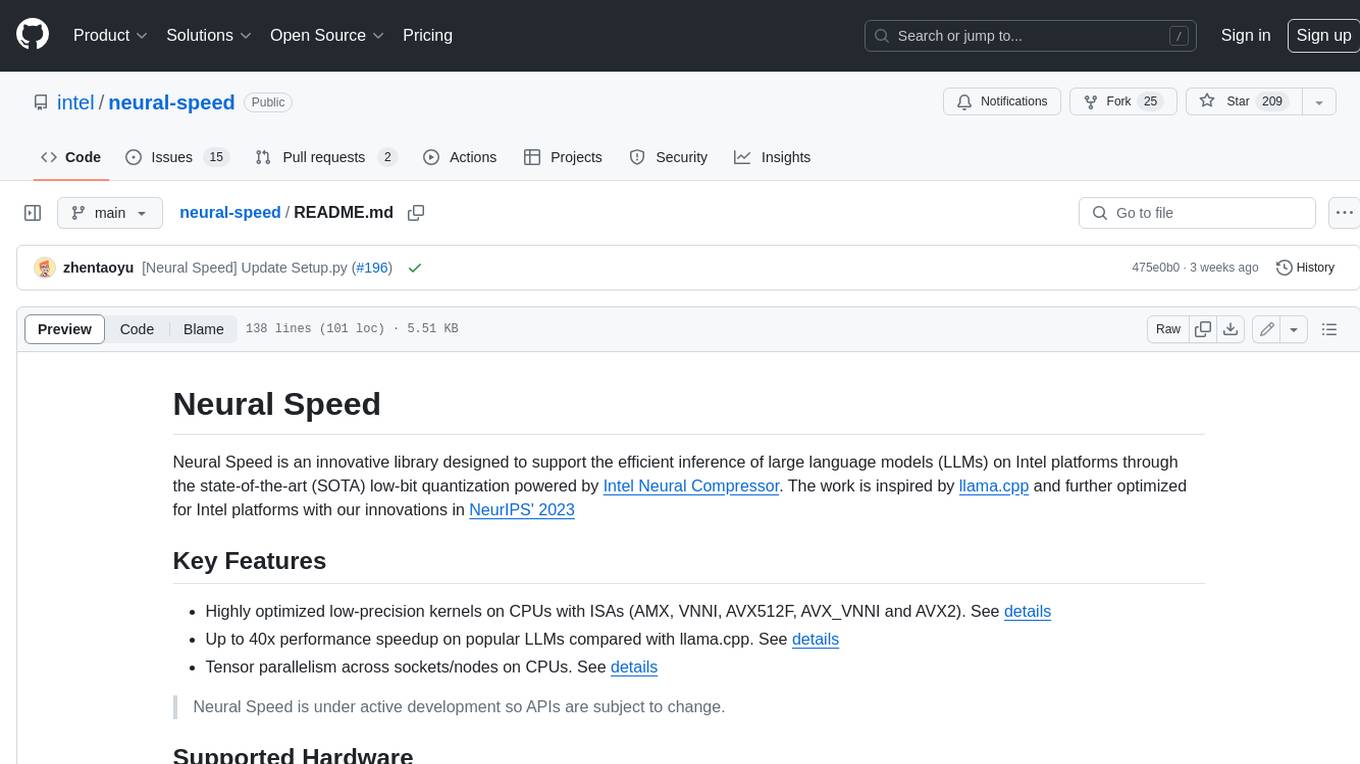
neural-speed
Neural Speed is an innovative library designed to support the efficient inference of large language models (LLMs) on Intel platforms through the state-of-the-art (SOTA) low-bit quantization powered by Intel Neural Compressor. The work is inspired by llama.cpp and further optimized for Intel platforms with our innovations in NeurIPS' 2023










